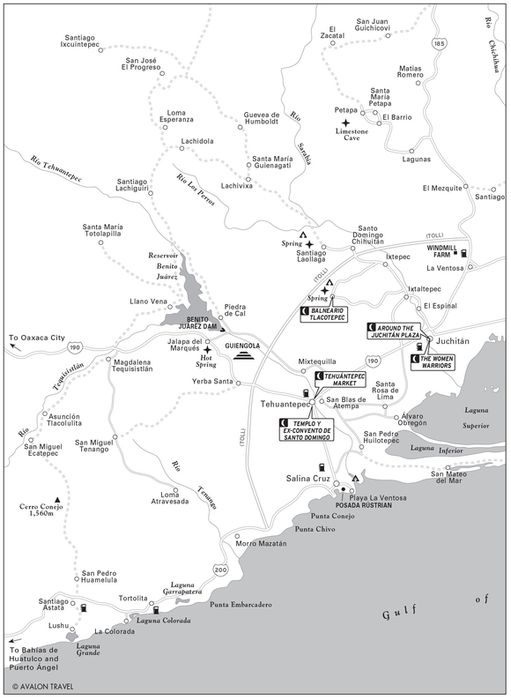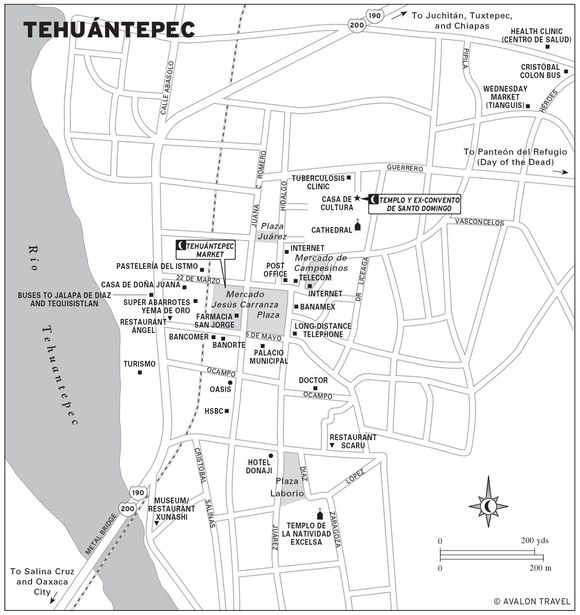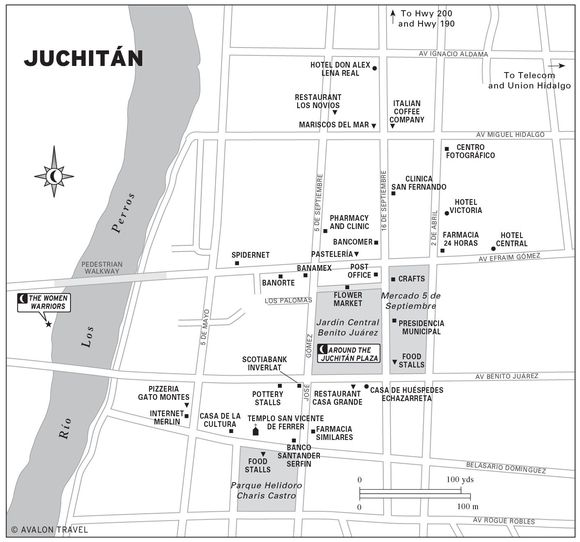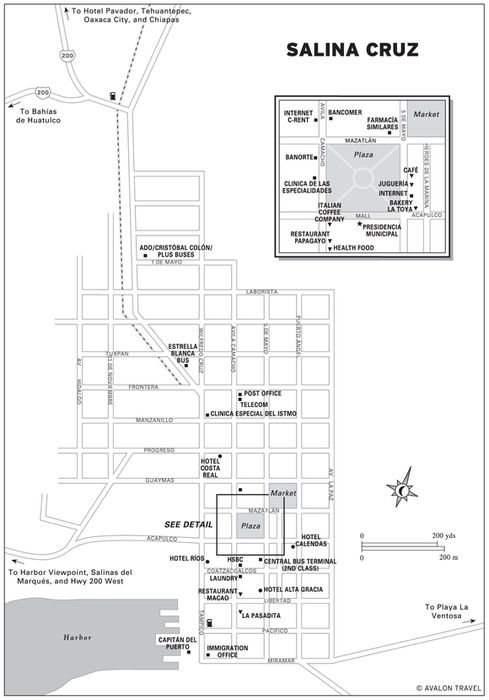THE ISTHMUS
A trip to the Isthmus of Tehuántepec from the Oaxaca central highlands sometimes seems like a journey to another country. At the Isthmus, the North American continent narrows to a scarce 160 kilometers (100 mi) in width; the mighty Sierras shrink to mere foothills. The climate is tropical; the land is fertile and well watered. Luxuriant groves hang heavy with almonds, avocados, coconuts, mangos, and oranges. Rivers wind downhill to the sea, springs well up at the foot of mountains, and swarms of fish swim offshore. The Isthmus is a land of abundance, and it shows in the people. Women are renowned for their beauty, independent spirit, and their incomparably lovely flowered skirts and blouses, which young and old seem to wear at any excuse.
And they have excuses aplenty, for the Isthmus is the place of the velas, called fiestas in other parts of Mexico. But in the Isthmus, especially in the towns of Tehuántepec and Juchitán, where istmeño hearts beat fastest, velas are something more special. Most every barrio (neighborhood) must celebrate one in honor of its patron saint. A short list names 20 major yearly velas in Juchitán alone. The long list, including all the towns in the Isthmus, numbers more than 100.
If you’re lucky to arrive during one of these velas, you may even be invited to share in the fun. Local folks dress up, women in their spectacularly flowered traje (traditional indigenous dress) and men with their diminutive Tehuántepec sombreros, red kerchiefs, sashes, and machetes. Sometimes entire villages or town barrios celebrate for days, eating, drinking, and dancing to the beautiful melody of “La Sandunga,” which, once you’ve been captured by its lovely, lilting strains, will always bring back your most cherished Isthmus memories.
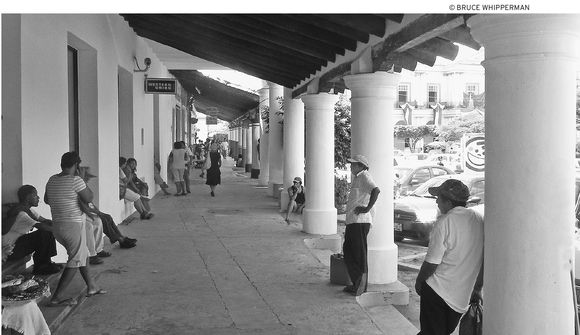
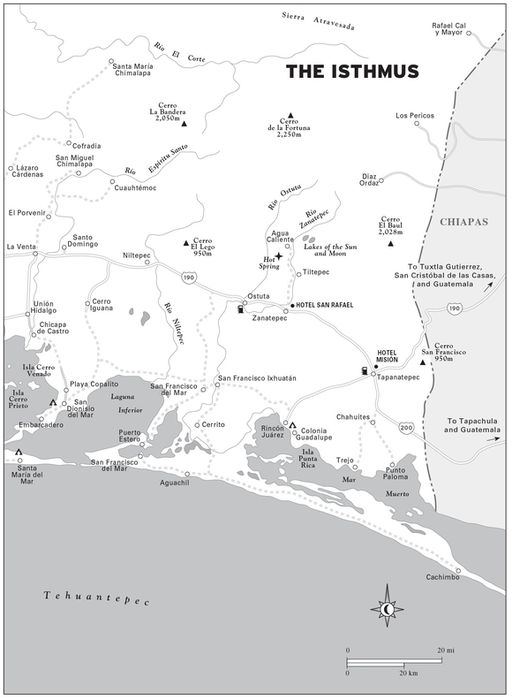
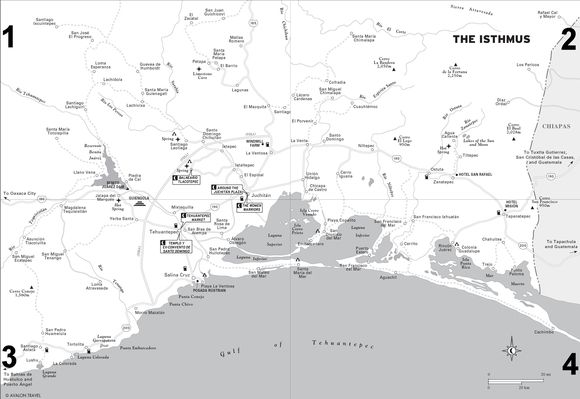
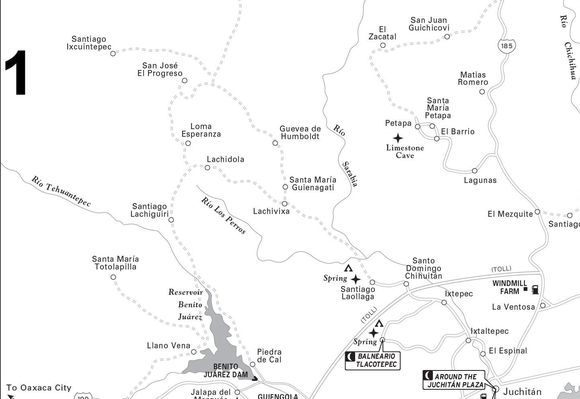
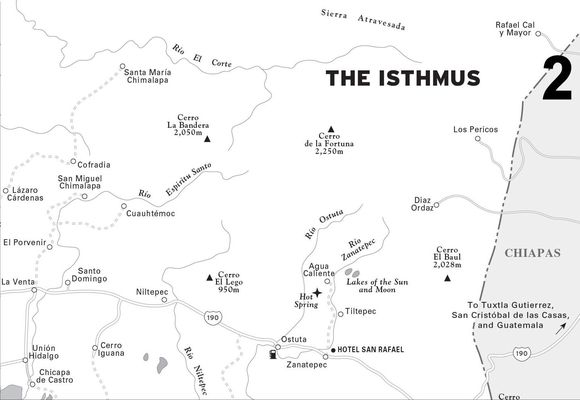
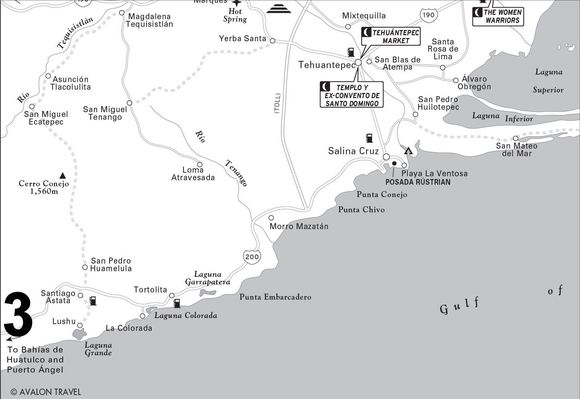
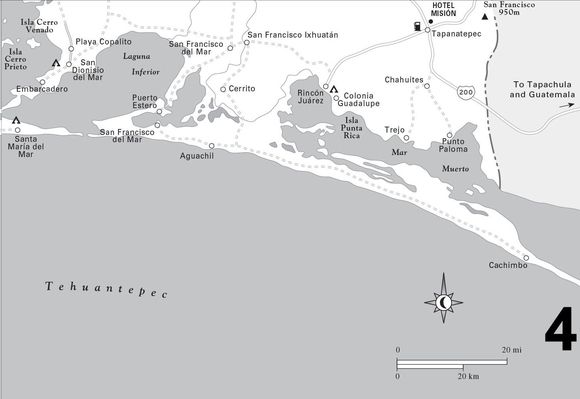
HIGHLIGHTS
 Templo y Ex-Convento de Santo Domingo: Around the Tehuántepec town plaza, the highlight is the church and partially restored, circa 1530 Templo y Ex-Convento de Santo Domingo. Be sure to see the recently discovered wall decorations painted by indigenous artists 450 years ago (
Templo y Ex-Convento de Santo Domingo: Around the Tehuántepec town plaza, the highlight is the church and partially restored, circa 1530 Templo y Ex-Convento de Santo Domingo. Be sure to see the recently discovered wall decorations painted by indigenous artists 450 years ago ( Templo y Ex-Convento de Santo Domingo).
Templo y Ex-Convento de Santo Domingo).
 Tehuántepec Market: The native women, in their extravagant and colorful floral huipiles, steal the show at the Tehuántepec market (
Tehuántepec Market: The native women, in their extravagant and colorful floral huipiles, steal the show at the Tehuántepec market ( Tehuántepec Market).
Tehuántepec Market).
 Around the Juchitán Plaza: The flowers, gold filigree, and flowery embroiderered huipiles for sale, not to mention the all-female cadre of vendors, are the main attraction on the Juchitán plaza (
Around the Juchitán Plaza: The flowers, gold filigree, and flowery embroiderered huipiles for sale, not to mention the all-female cadre of vendors, are the main attraction on the Juchitán plaza ( Around the Juchitán Plaza).
Around the Juchitán Plaza).
 The Women Warriors: From the river bridge, enjoy the airy view and cooling breeze, then cross over to the west bank and admire the Women Warriors, stainless steel guardians of Juchitán (
The Women Warriors: From the river bridge, enjoy the airy view and cooling breeze, then cross over to the west bank and admire the Women Warriors, stainless steel guardians of Juchitán ( The Women Warriors).
The Women Warriors).
 Balneario Tlacotepec: Heroine Princess Donaji donated this precious crystal spring and park for Isthmus people to enjoy, something they have done with gusto for more than four centuries (
Balneario Tlacotepec: Heroine Princess Donaji donated this precious crystal spring and park for Isthmus people to enjoy, something they have done with gusto for more than four centuries ( Balneario Tlacotepec).
Balneario Tlacotepec).
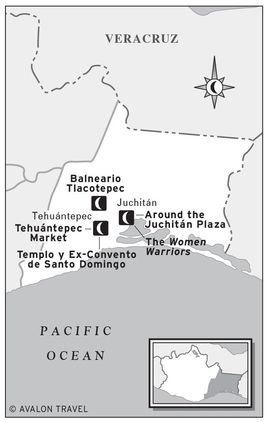
LOOK FOR  TO FIND RECOMMENDED SIGHTS, ACTIVITIES, DINING, AND LODGING.
TO FIND RECOMMENDED SIGHTS, ACTIVITIES, DINING, AND LODGING.
PLANNING YOUR TIME
A convenient route to including the Isthmus in your Oaxaca plan would be with a circular side trip, including the vibrant market towns of Tehuántepec and Juchitán en route between Oaxaca City and the Pacific resorts. For example, you could bus, drive, or fly south to the coast, spend some days basking in the South Seas ambience of the Pacific resorts, then begin your return to Oaxaca City east along the coast by either bus, car, or tour, enjoying four days along the way exploring the colorful markets, cuisine, and sights, both manufactured and natural, of the Isthmus.
For example, be sure to do plenty of strolling, and perhaps some shopping, in the fascinatingly colorful Tehuántepec Market hubbub, highlighted especially by the tehuana women in their radiantly colorful native dress. Along the way, be sure to do as the local folks do and hop aboard a motocarro (small motorcycle truck) for a ride around town. Later, don’t miss enjoying at least one deliciously authentic Tehuántepec meal in the showplace Restaurant Scaru. With an additional day, you could enjoy a day trip to Guiengola ruined mountain fortress city, continuing on for a soak in the authentically rustic agua caliente (warm spring) at Jalapa del Marqués village, and/or a lake bass dinner at restful garden Restaurant Del Camino.
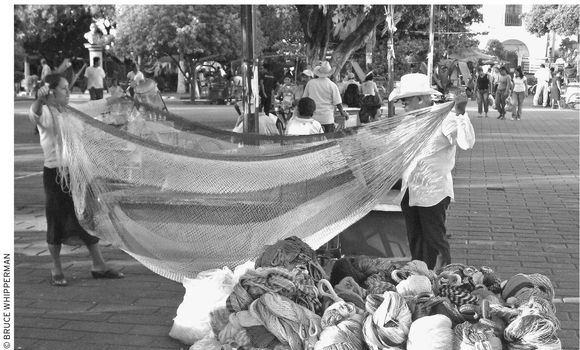
hammocks for sale in Juchitán
The next day, continue east half an hour to Juchitán. Here, soak in the colorful scene with plenty of strolling around the Juchitán plaza and market. Along the way, be sure to see the vibrant flower and handicrafts stalls, with riots of roses and lilies and their gold filigree, exquisite flowered huipiles, bright hammocks, multicolored pottery, and much more. Take a break with lunch in the airy inner patio of the plaza-front Restaurant Casa Grande. In the later afternoon, don’t miss strolling a few blocks west to enjoy the breeze and view from the tranquil Río Los Perros riverbank. And especially don’t miss taking a look at the monumental Women Warriors stainless steel sculptures overlooking the river.
Finally, enjoy another day by taking a picnic (and your bathing suit) to the historical and uniquely lovely Isthmus excursion park, at the crystalline blue springs that bubble up at Balneario Tlacotepec, about an hour by bus north of Juchitán.
Tehuántepec and Vicinity
Although both Juchitán and Salina Cruz are the Isthmus’s big, bustling business centers, quieter, more traditional Tehuántepec remains foremost in the minds of most istmeños as the former pre-Columbian royal capital, the seat of Cosijopí, the beloved last king of the Zapotecs. Local people are constantly reminded of their rich royal history by virtue of the Templo y Ex-Convento de Santo Domingo, the construction of which was unique in Oaxaca because it was financed by an indigenous monarch, Cosijopí. Moreover, local people can directly see their ancestors’ contribution to history by glimpsing the ancient (recently discovered) floral and animal decorations that their ancestors painted on the walls of the ex-convent nearly half a millennium ago.
The town of Tehuántepec is geographically the center of the Isthmus. Roads, like spokes of a wheel, branch out in all directions, south to Salina Cruz, northeast to Juchitán, and northwest to Oaxaca City. This means that travelers from Oaxaca City most easily reach both Juchitán and Salina Cruz by passing through the fortunate town of Tehuántepec.
HISTORY
Although strictly connected only with a single location, the name Tehuántepec (Hill of the Jaguar) is, in many minds, synonymous with the entire Isthmus region: thus the label the “Isthmus of Tehuántepec.” The connection is historical, for Tehuántepec’s dominance was born in events of long ago.
The earliest known settlers in the Isthmus left Olmec-style remains, which archaeologists date from as early as 4000 B.C. Much later, around 500 B.C., the Olmecs’ inheritors, probably the ancestors of present-day Mixe- and Huave-speaking people, occupied the Isthmus lands. But times changed, and by A.D. 500 the Isthmus had become a strategic funnel: a trade gateway between the great civilizations, such as Teotihuacán and Monte Albán, of the Mexican central highlands, and the rich Mayan cultures of Chiapas, Yucatán, and Guatemala.
Eventually, the more populous Zapotec-speaking people displaced the Mixe and Huave in the Isthmus. By A.D. 1400, the Zapotec kings of Zaachila in Oaxaca’s central valley controlled the Isthmus gateway with a mountaintop fort at Guiengola, which guarded their Isthmus capital at the present-day town of Tehuántepec.
The ambitious Aztec emperors also coveted the Isthmus gateway. In the 1440s, they sent armies to Oaxaca to pressure the Mixtec and Zapotec kingdoms, who allied themselves against the Aztecs. But forced by Aztec victories in 1486, many Zapotec people, including their king Cosijoeza, retreated from Zaachila and took refuge in Tehuántepec. There, together with the Mixtecs under King Dzahuindanda, the Zapotecs, attacking from their stronghold at Guiengola, held off the Aztecs, who offered Emperor Moctezuma’s daughter in marriage to King Cosijoeza as part of a peace pact.
With tranquility established, Cosijoeza returned to reign once again over Zaachila, leaving his son, Cosijopí, as king of the Isthmus, with his court at Tehuántepec. Later, when the Spanish arrived, King Cosijopí joined with Cortés against the Aztecs. After Aztec power was erased, Cosijopí, along with thousands of his subject-inhabitants of Tehuántepec, converted to Christianity.
ORIENTATION
Although the Río Tehuántepec splits the Santo Domingo Tehuántepec town (pop. 52,000) along a roughly north–south line, the west-side portion, across the river via the Puente Metalico (Metal Bridge), first built for locomotives around 1900, seems like a mere suburb of the town center, east of the river. On the central plaza itself, the presidencia municipal occupies the south side, along Calle 5 de Mayo; the main market, Mercado Jesús Carranza, lies on the plaza’s west, river side, along Calle Juana C. Romero; and to the northeast, past the end of main north–south street Benito Juárez, about a block and a half northeast of the plaza, stands Tehuántepec’s most venerable monument, the Templo y Ex-Convento de Santo Domingo.
SIGHTS
Around the Plaza
First, take a stroll around the plaza, where you’ll find some interesting sculptures, including noble likenesses of Miguel Hidalgo (the Father of Mexican Independence) and a pair of Tehuántepec heroes. On the north side, look for the bronze of a seated Doña Juana Catalina Romero (1855–1915), a Tehuántepec legend. She is famous partly for her good works, establishing schools for Tehuántepec children during the days when public education was a rarity in Mexico.
On the plaza’s west (market) side, you’ll find the bronze bust of A. Maximino Ramón Ortiz, the first and only governor of the Isthmus, when it was separated from Oaxaca as the territory of Tehuántepec for a few years during the 1850s. Politics, however, were not Ortiz’s first love. He is best remembered as the composer of “La Sandunga,” Tehuántepec’s beloved theme. His ageless melody seems to perfectly capture the essence of the Isthmus in a gracefully drowsy rhythm that swings slowly, yet deliberately, like the relaxed sway of lovers in a hammock beneath the deep shade of a Tehuántepec grove.
 Templo y Ex-Convento de Santo Domingo
Templo y Ex-Convento de Santo Domingo
From the plaza’s northeast corner, walk north along Calle Hidalgo one block to the venerable Santo Domingo church, behind its broad fenced atrium, on the right. The aging landmark (to the left of the new church) is interesting partly because it was one of the few, if not the only, Christian churches in Mexico financed by a native ruler. Cosijopí, the last king of the Zapotecs, was baptized as Juan Cortés de Cosijopí after his friend and ally Hernán Cortés paid for the construction with both cash and the labor of thousands of his subjects. The building was erected under the supervision of Fray Fernando de Albequerque, vicar of Tehuántepec, between 1544 and 1550.
Given the warm relations between King Cosijopí and the Spanish, it is ironic that the Inquisition authorities burned Cosijopí at the stake a generation later for continuing (and for encouraging his people) to worship the old gods.
Enter through an interior side door, off the left-aisle of the very attractive new church. Inside, old Santo Domingo’s most remarkable feature is its lovely wooden tabla (altarpiece), with an unusual ebony Lord of Creation perched on its crest, with a dog, turtle, and deer in tow. (At last visit, the ebony statue had been removed, but a local priest told me that it would probably be returned after the present church remodeling work is finished.)
The ex-convent section, on the old church’s north side, was abandoned not long after the Reforms of the late 1850s forced the Dominicans from Mexico. It had crumbled into a virtual ruin by the mid-20th century, when local people rolled up their sleeves and began restoring it in 1953. In 1982, with the restoration complete, the townsfolk christened their ex-convent as the Casa de la Cultura (tel. 971/715-0114, 9 A.M.–2 P.M. and 5–8 P.M. Mon.–Fri., 9 A.M.–2 P.M. Sat.). Now, in the evenings it resounds with the noises of young musicians and dancers at practice.
To take a look inside the restored ex-convent, retrace your steps out across the atrium, turn right at Calle Hidalgo, and walk north. After two short blocks, turn right at Guerrero. Walk one long block. Just after the tuberculosis clinic (formerly centro de salud) turn right into an alley, which leads directly south to the Casa de la Cultura and the old convent.
Inside the Casa de la Cultura, look for the faded but still-visible flower and animal motifs that Cosijopí’s long-gone artists painted on the walls nearly four centuries ago. Head upstairs where the ancient wall decorations appear as fresh as if they were painted only a generation ago. In other upstairs rooms you’ll see a host of historical mementos, from ancient Olmec-style figurines to a lovely jade necklace, once scattered, but excavated piece by piece and finally reassembled here. (Sometimes the upstairs is closed. If so, it’s worth seeking permission from the administrative secretary on the ground floor, in the cloister, to let you go upstairs.)
 Tehuántepec Market
Tehuántepec Market
The most colorful downtown action goes on at the Mercado Jesús Carranza, just across Romero from the plaza. At midday, the market overflows with life. The center of everything is the corridor street on the market’s north side, which connects the plaza with the businesses along the railroad tracks behind the market.
The buzzing motocarros (motorcycle mini-trucks) that you see depositing and picking up passengers by the railroad track seem to be a unique Isthmus invention. They mostly follow set round-trip routes around town for a fixed price of about $1 (10 pesos). When you get tired of walking, hop on for a breezy whirlwind tour of Tehuántepec’s back streets.
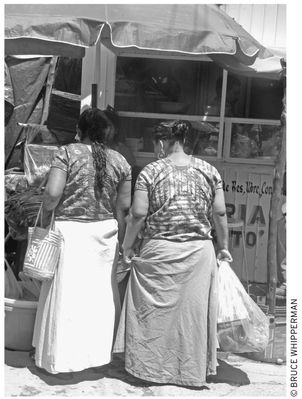
Women do virtually all the buying and selling at the Tehuántepec Market.
See JUAN CATALINA ROMERO: HEROINE OF TEHÚANTEPEC
Market vendors, especially women in traje (traditional indigenous dress), tend to be apprehensive of rubber-necking strangers with cameras in hand. A good strategy is to blend in. Get a refresco (refreshment) at one of the food stalls and find a low-profile spot in the shade where you can take in the passing scene.
Get some relief from the heat and bustle inside the roofed market building itself. If you’re in the mood for shopping, plenty of handicrafts are available. On the bottom floor, stalls offer the gold filigree jewelry (at this writing, mostly faux-gold filigree, since gold is so expensive) that the Tehuántepec women love to wear. Look farther for lots of woven goods, such as baskets, string bags of ixtle fiber, hand fans, and hammocks. One unusual item that you may see during the late spring are large, one-meter-long (three-foot-long) pods of decorative flowers of coyul.
Upstairs, via the stairway on the southwest corner by the railroad track, you’ll find Tehuántepec’s pride—the beautiful embroidered tehuana flowered blouses and skirts. Look around, decide what you want, then bargain for it. Asking prices for the prized, embroidered flower–design blouses run as much as $100, a whole outfit about $200, with bargaining.
Behind the market runs the railway track, which has the distinct appearance of being abandoned, because dozens of vendors regularly set up where trains should come rolling through.
Pottery, including many big, homely items—bowls, griddles, planters, pots—is for sale at the second downtown market, the lackluster Mercado 5 de Febrero, sometimes known as the Mercado de Campesinos, tucked at the plaza’s northwest corner. Smaller for-sale items include pots painted with bright flowers as well as woven goods, such as baskets, fans, and handmade brooms and piñatas.
Besides the two aforementioned permanent daily markets near the plaza, country people flood into town for tianguis (native town market) on Wednesday and Sunday. Visit the Wednesday tianguis, set up along north-side Calle Héroes, most easily by riding a motocarro from the plaza. Alternatively, from the plaza, walk north along Hidalgo past the church. Two blocks from the plaza, turn right at Guerrero and continue several blocks to the blue-trimmed San Juan Bautista church, where you turn left at Héroes. After a few blocks, you’ll see the awnings stretched along side streets.
The Sunday tianguis is much bigger, so much so that it’s held on the west side across the river, beyond the big Oaxaca highway intersection, in the open space behind the Hotel Gueixhoba.
Casa de Doña Juana Catalina Romero
The railway track so intimately close to the market is due to the speculated intimate relationship between President Porfirio Díaz and local beauty Doña Juana Catalina Romero (1837–1915). Doña Juana Catalina lived in the French-style mansion, now in faded white with fancy blue window awnings in need of serious renovation, which rises by the tracks. Some say that the tracks were built right out front so Díaz could visit her with ease. Until recent years Doña Juana Catalina’s elderly granddaughter resided there. Lately, with her retirement, her heirs subsequently sold the house to another family. It is rumored that the state and community are planning to buy it and convert it into a museum.
La Cueva
If you feel like an early-morning or late-afternoon walk, head for La Cueva (The Cave), as local folks call it. It’s visible most of the way up the hill called Liesa, across the river about three kilometers (two mi) west of town. La Cueva has been hallowed ground for as long as anyone remembers. Local folks tell stories about the existence of a secret passageway somewhere at the back of the cave that leads all the way to Guiengola, the “old town,” now a mysterious ruin on the mountain 16 kilometers (10 mi) to the west.
La Cueva still draws virtually everyone in town for a pilgrimage during both Semana Santa (Good Friday) and Día de la Cruz (May 3). It’s best not to try the climb during the heat of the day (allow at least an hour for the whole excursion). In order to get a head start, spend a couple of dollars (20 pesos) on a taxi or motocarro (motorcycle mini-truck) to take you to the base of the hill.
Plaza Laborio
A number of smaller plazas dot Tehuántepec’s several barrios. If you head south along Juárez two long blocks, you’ll arrive at Plaza Laborio and its adjacent blue-trimmed, storybook Templo de la Natividad Excelsa. Before you go inside to look around, notice that the right bell tower is tilted at a crazy angle, not unlike the Leaning Tower of Pisa. Laborio (the name of the church’s barrio) residents don’t seem to worry. “It’s been like that for years,” they say.
Plaza Laborio is mostly sleepy, except during the August 31–September 11 Fiesta Laborio, when residents and visitors celebrate with a long menu of feasts, dancing, fireworks, and calendas (processions).
Museum and Restaurant Xunashi
Housed in a colonial-era family mansion-factory, this museum (Callejon El Faro 1A, local cell tel. 971/129-7990, noon–5 P.M. daily, $3) is decorated with a flock of antiques, that range from a giant portrait of the Virgin of Guadalupe and ancient wooden looms, to an entire chapel of devotional memorabilia and a whole kitchen of great pottery jugs.
Welcoming owners Jose Manuel Villalobos and his wife Mari Carmen and their children offer a hearty Mexican comida (noon–5 P.M. daily, $6) in their baronial river-view dining room. Get there either by short taxi ride from the plaza, or walking two blocks south from the plaza’s southwest corner. Turn right at the Hotel Donaji (corner of Plaza Laborio) and continue another two blocks, to the corner of Cristobal Salinas. Turn left one block, then turn right and continue a short block to the mansion, above, on the right.
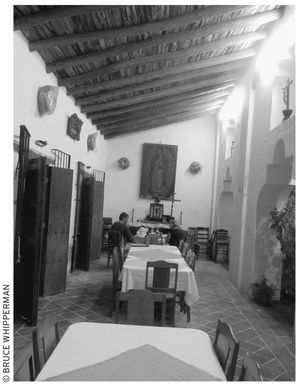
Museum and Restaurant Xunashi offers a hearty Mexican lunch in the midst of colonial-era furnishings.
Barrio de Santa María
Also worth a visit, across the river, is the Barrio de Santa María. (Get there by bearing left at the street heading diagonally left from the highway, a block or two west of the river bridge; after about two more blocks, go left again.) The main community pride and joy is the (also bright blue and white) Templo de la Virgen de la Asunción. The church, by the same architect who built the famous pilgrimage church in Juquila, is the focus of a busy round of barrio events. The bustle climaxes during the August 13–18 Fiesta Patronal del Barrio de Santa María Reolotoca, with a calenda (procession), parade of flower-decorated bull-drawn carts, and earsplitting popular dances on three successive nights. Bring your earplugs.
ACCOMMODATIONS
Under $50
Tehuántepec offers visitors at least three hotels: one is semi-deluxe, in the west suburb; and a pair downtown is more modest, but very recommendable. A good choice downtown is the Oasis (Melchor Ocampo 8, tel. 971/715-0008, fax 971/715-0835, www.hotelesdeoaxaca.com, hoteloasistehuantepec.html, h.oasis@hotmail.com, ($18 s, $22 d one bed, $26 d in two beds, $30 t with fans; or $30 s, $35 d with a/c), removed a block south from the plaza hubbub, behind the presidencia municipal. Although at first glance the Oasis doesn’t appear very exciting, a closer examination reveals the talents of the owner, friendly English-speaking artist Julín (hoo-LEEN) Contreras, whose work decorates the hotel’s restaurant wall. (She was also commissioned to do the mural in the council chamber on the 2nd floor of the presidencia municipal.)
The hotel building offers four stories of 28 clean and comfortable rooms that enfold in an invitingly leafy and tranquil inner patio. The rooms feature colorful bedspreads and curtains, walls decorated with the owner’s art, and private warm-water shower-baths. In most rooms, windows open to a garden, mountain, or river view. Pottery and plants selected by the owner decorate hotel niches and corridors. In the building’s inner patio, a towering chico zapote tree stretches skyward. A parking lot provides security for cars. There is a good, relaxed, Restaurant Almendro (Almond Tree). Visa credit cards and dogs and cats are accepted. For lovers of the way Mexico “used to be,” this is the place. Besides all of the above, Julín invites guests to visit her on-site art studio and also offers Isthmus culinary tours. A couple of minuses are the hotel’s corridor rooms, where curtains must be drawn for privacy, and the hotel’s sometimes lackadaisical desk staff.
An arguably better choice downtown is the Hotel Denali (Juarez 10, tel. 971/715-0064, fax 971/715-0448, hoteldonaji@hotmail.com, $20 s, $25 d fan only, $30 s, $35 d with a/c), named for Oaxaca’s beloved Apothecia heroine and located two blocks south of the plaza on quiet Plaza Laborio. This renovated hotel is very popular locally by virtue of its inviting, plant-decorated inner restaurant patio. The 48 rooms, in a big two-story block, are simply but invitingly decorated, with hot-water shower-baths, cable TV, a small pool-patio, and credit cards accepted.
Over $50
Tehuántepec’s fanciest hotel is the four-star  Hotel Guiexhoba (ghee-ay-SHOW-bah; Carretera Panamericana Km 250.5, Barrio Santa María, tel./fax 971/715-1710 or 971/715-0416, guiexhoba@prodigy.net.mx, $45 s, $58 d, $70 t), which deserves extra points simply for its Zapotec label, the name of a locally abundant white flower with a fragrant scent reminiscent of jasmine. The hotel has a specimen bush, which blooms during the summer rainy season, by the front entrance. Find the hotel on Highway 190, inbound from Oaxaca City on the right before the bridge.
Hotel Guiexhoba (ghee-ay-SHOW-bah; Carretera Panamericana Km 250.5, Barrio Santa María, tel./fax 971/715-1710 or 971/715-0416, guiexhoba@prodigy.net.mx, $45 s, $58 d, $70 t), which deserves extra points simply for its Zapotec label, the name of a locally abundant white flower with a fragrant scent reminiscent of jasmine. The hotel has a specimen bush, which blooms during the summer rainy season, by the front entrance. Find the hotel on Highway 190, inbound from Oaxaca City on the right before the bridge.
The Guiexhoba’s 36 spacious, clean, and comfortable rooms, in two stories, enclose a parking courtyard that fortunately shields rooms on its north side from highway noise. Staff are generally attentive, competent, and courteous. The upstairs rooms away from the highway are quiet and have fewer people walking past the windows, whose drapes, unfortunately, must be drawn for privacy. Amenities include big pool, parking, cable TV, air-conditioning, hot-water shower-baths, credit cards accepted, in-house Internet, and the very good Restaurant Guiexhoba.
FOOD
Groceries and Treats
Tehuántepec’s freshest fruit and vegetable sources by far are the luscious mounds of avocados, bananas, carrots, lettuce, mangos, pineapples, radishes, and much more in the plaza market. Likewise, find the best grocery sources, such as the Super Abarrotes Yema (tel. 971/715-0489, 8 A.M.–8:30 P.M. daily), by the railroad tracks just west (river side) of the market.
Satisfy your sweet tooth with the baked offerings of the Super Panadería y Pastelería del Istmo (tel. 971/715-0808, 8 A.M.–8:30 P.M. daily). Find it on the railroad tracks, just north of the market, on the left. For evening snacks, fill up at the taco stalls lined up behind the presidencia municipal.
Restaurants
You’ll probably find that it’s most convenient to have breakfast at your hotel, such as the Restaurant Almendro (Melchor Ocampo 8, tel. 971/715-0008, fax 971/715-0835, www.hotelesdeoaxaca.com) of the Oasis hotel and the restaurant at the Hotel Guiexhoba. Otherwise go to Tehuántepec’s best, the refined Restaurant Scaru, three blocks south of the plaza.
Tehuántepec offers a sprinkling of good sit-down restaurants. By far the most colorful is the  Restaurant Scaru (at south-side cul-de-sac Callejon Leona Vicario 4, tel. 971/715-0646, 8 A.M.–11 P.M. daily, $5–10). Here, in a graceful, airy setting, owners lovingly portray picturesque aspects of traditional Isthmus life. Walls bloom with murals of fruit, festivals, and lovely tehuanas in their bright, flowery costumes, while patios are sprinkled with hammocks and sheltered overhead by luxurious handcrafted palapas. Saturday and Sunday afternoons 2–6 P.M., a marimba band will play “La Sandunga” to your heart’s content. After such a luscious introduction, the food, from a very recognizable menu of salads, soups, eggs, pastas, meats (including some game), fish, and fowl, is no less than you would expect. Get there from the plaza by walking two long blocks south along Juárez to Plaza Laborio. Turn left and walk one block to Callejon Leona Vicario on the left; the restaurant is on the uphill side of the street. Credit cards are not accepted.
Restaurant Scaru (at south-side cul-de-sac Callejon Leona Vicario 4, tel. 971/715-0646, 8 A.M.–11 P.M. daily, $5–10). Here, in a graceful, airy setting, owners lovingly portray picturesque aspects of traditional Isthmus life. Walls bloom with murals of fruit, festivals, and lovely tehuanas in their bright, flowery costumes, while patios are sprinkled with hammocks and sheltered overhead by luxurious handcrafted palapas. Saturday and Sunday afternoons 2–6 P.M., a marimba band will play “La Sandunga” to your heart’s content. After such a luscious introduction, the food, from a very recognizable menu of salads, soups, eggs, pastas, meats (including some game), fish, and fowl, is no less than you would expect. Get there from the plaza by walking two long blocks south along Juárez to Plaza Laborio. Turn left and walk one block to Callejon Leona Vicario on the left; the restaurant is on the uphill side of the street. Credit cards are not accepted.
Second choice goes to the good but more ordinarily picturesque restaurant at the Hotel Guiexhoba (Hwy. 190 Km 250.5, tel. 971/715-1710, 7:30 A.M.–10 P.M. daily, $5–12), across the river. The food, from a typical but tasty menu of breakfast (eggs and pancakes), lunch (hamburgers, soups, and stews), and dinner (meat, fish, fowl, and spaghetti), sometimes comes with a flaming crepe Suzette flourish. Credit cards are accepted.
Back downtown, for a restful comida, go to the singularly interesting Museum and Restaurant Xunashi (Callejon El Faro 1A, local cell tel. 971/129-7990, noon–5 P.M. daily).
INFORMATION AND SERVICES
Tourist Information
For travel recommendations and help in emergencies, go to the friendly Turismo office (on Hwy. 200 south, Salina Cruz direction, no phone, 9 A.M.–7 P.M. daily), overlooking the Río Tehuántepec, two blocks west and two blocks south of the town plaza, before the river bridge.
Health and Emergencies
A number of town pharmacies provide both over-the-counter remedies and prescription drugs. Perhaps the best stocked is the town-center branch of the Farmacia San Jorge (Romero, 8 A.M.–8 P.M. daily), located in a permanent street stall, right on Romero, on the market side of the town plaza.
If you need to consult a doctor, you can always find one at the big 24-hour Hospital Materno (Hwy. 190, tel. 971/713-7252) across from the bus station.
Alternatively, you have another highly recommended choice, Dr. José Manuel Vichido (Calle Ocampo, tel. 971/715-0862, 9 A.M.–2 P.M. Mon.–Sat.). From the plaza’s southeast corner, walk south one block along Juárez; turn left at the first street, Ocampo. The doctor’s office is half a block farther on the left.
Police service is available from at least two sources in Tehuántepec. Call either the policía municipal (tel. 971/713-7000), or the emergency number (dial 066).
Money
Tehuántepec has some banks, all with ATMs. On the plaza’s southeast side, go to up-and-coming Banorte (5 de Mayo, 971/715-0140, 9 A.M.–4 P.M. Mon.–Fri.) across from the market. Next door, also find Bancomer (5 de Mayo, tel. 971/715-1253, 8:30 A.M.–4 P.M. Mon.–Fri.).
Communications
Both the correo (at the plaza’s northeast corner, tel. 971/715-0106, 8 A.M.–4:30 P.M. Mon.–Fri., 8 A.M.–noon Sat.), including rapid, secure Mexpost service, and telecomunicaciones (at the plaza’s northeast corner, tel. 971/715-1197, 8 A.M.–5 P.M. Mon.–Fri., 9 A.M.–noon Sat. and Sun.), for money orders and public fax, stand side by side at the plaza’s northeast, Calle Hidalgo, corner.
Long-distance telephone, fax, and photocopies are available at Papelería La Esfera (at the plaza’s southeast corner, tel. 971/715-0042, fax 971/715-2090, 8 A.M.–8 P.M. Mon.–Sat., 9 A.M.–2 P.M. Sun.).
Find Internet access at Fusion (Hidalgo, no phone, 9 A.M.–10 P.M. daily), a short block north of the plaza, across from the little Juárez park.
GETTING THERE AND AWAY
By Bus
The vintage Tehuántepec bus station was supposed to be replaced years ago by a brand-new terminal, which remains yet unused. Meanwhile, on Highway 190-200, about a mile north of the town plaza, the old bus terminal (tel. 971/715-0108 for information and reservations for nearly all departures) still bustles with activity. Get there by taxi or motocarro (motorcycle mini-truck) from the plaza.
Four major bus lines, first-class Autobuses del Oriente (ADO) and Omnibus Cristóbal Colón (OCC), and mixed first- and second-class Sur and Autobuses Unidos (AU), offer many connections. Departures connect north and east via Juchitán with Tuxtepec, Villahermosa, Palenque, Minatitlán, Coatzacoalcos, Mérida, Cancún and Tulum; northwest with Oaxaca City, Puebla, and Mexico City; southwest with Salina Cruz, Bahías de Huatulco, Pochutla (Puerto Ángel), and Puerto Escondido; and east via Juchitán, Tuxtla Gutiérrez, San Cristóbal las Casas, and Tapachula at the Guatemala border.
See SCOOTING AROUND BY MOTOCARRO
In addition, from an adjacent terminal, a pair of independent second-class cooperating lines, Oaxaca Istmo and Fletes y Pasajes offer connections northwest with Oaxaca City and west with Bahías de Huatulco, Pochutla (Puerto Ángel), and Puerto Escondido, while Fletes y Pasajes also offers connections northwest with Oaxaca City, southwest with Salina Cruz, and northeast with Juchitán.
By Car
Good paved roads fan out from Tehuántepec in four directions. Highway 190-200 connects northeast with Juchitán (27 km/17 mi), then splits north as Highway 185 at La Ventosa and continues north, via Matías Romero and Minatitlán, all the way to the Gulf of Mexico at Coatzacoalcos, a total of 267 kilometers (166 mi). Allow about 4.5 driving hours, either way, for this relatively easy trip.
For Tuxtepec and northern Oaxaca, from cross-Isthmus Highway 185, turn onto Highway 147 at Matías Romero and continue northwest a total of 304 kilometers (189 mi) from Tehuántepec. Allow about five hours of driving time. Note: In the past, some robberies have occurred on the long (two-hour), lonely Highway 147 Matías Romero–Tuxtepec leg. Although security now appears to not be a problem, authorities still advise travelers to restrict their driving to daytime only on this stretch.
Highway 190 connects Tehuántepec northwest with Oaxaca City along 250 kilometers (155 mi) of well-maintained but winding highway. Allow about 5 hours in Oaxaca City direction (uphill), 4.5 hours in the opposite direction.
Highway 200 connects Tehuántepec west with the Oaxaca Pacific coast, via Salina Cruz (15 km/9 mi), Bahías de Huatulco (161 km/100 mi, three hours), Pochutla–Puerto Ángel (200 km/124 mi, four hours), and Puerto Escondido (274 km/170 mi, five hours) on paved, moderately traveled, secure highway.
Combined Highway 190-200 connects Tehuántepec east via Juchitán (27 km/17 mi) and Niltepec to Tapanatepec (126 km/78 mi) near the Chiapas border and beyond to Guatemala. Allow about 3.5 hours of driving time to Tapanatepec.
Drivers should fill up with gasoline at the Pemex gasolinera on the west side of the river, about two kilometers (1.2 mi) west of the bridge, where the road splits southwest to Salina Cruz, northwest to Oaxaca City.
EXCURSIONS WEST OF TEHUÁNTEPEC
The interesting destination trio of Guiengola, Jalapa del Marqués, and Tequisistlán can be combined into a full-day auto or taxi excursion (two days by bus) west of Tehuántepec. Along the way, enjoy a vigorous hike through pristine forest to the regal ruined fortress-city at Guiengola, a breezy boat ride on the Jalapa del Marqués reservoir, a soak in the community hot (actually just warm) spring, and a look at what is probably the world’s only marble basketball court, topped off by a stop by the marble factory at Tequisistlán.
Guiengola
The mountain fortress Guiengola (ghee-ayn-GOH-lah, Big Rock in Zapotec) may have been abandoned before the Spanish arrived, but it was never forgotten. Local people refer to it as the “old town” and sometimes hear eerie voices up there. If so, they rush down the mountain before dark.
Ghosts notwithstanding, an excursion to Guiengola is a chance to get some fresh air into your lungs as you enjoy the Isthmus tropical forest up close—fluttering butterflies, spiny cactus, flowery trees, and fireflies and hoot owls (if you return at dusk).
At the end of the rough jeep road that winds about six kilometers (four mi) up Guiengola Mountain, you continue on foot via a sometimes steep three-kilometer (two mi), one-hour hike through summer-green (but brown in spring) tropical woodland. If you start early or leave late, you might see venado (deer), javelin (wild pigs), and, if you’re very lucky, a león (mountain lion).
You know you’re getting close to the ruins when the trail straightens out and you see a continuous series of vegetation-covered mounds and walls on both sides. You are following an ancient, regal street, lined with ruined houses of the nobility. Next, break out into the open, where a four-step unreconstructed noble pyramid, called the Pyramid of the Sun, rises at the right. On the opposite side, across a spreading, flat ceremonial plaza, another, even taller, five-step Pyramid of the Moon stands on your left. To the extreme left rises a big ball court, so well preserved that it appears as if a dozen persons could spend a weekend with machetes and a few shovels and put the place in order for a tournament on Monday.
What you see immediately around you is only the ceremonial center. Beneath the surrounding forest are dozens of mounds, remains of temples, ceremonial patios, and regal homes. The state of preservation is exceptional, partly because of the site’s isolation. These structures of stone and mud mortar are delicate and mostly unexplored; please refrain from climbing on them.
GUIDES AND GETTING THERE
In Tehuántepec, you can pre-arrange a tour led by highly recommended guide Victor Velasquez Guzman (tel. 971/714-4060, local cell tel. 044-971/122-3966, vicveneno@hotmail.com), who lives on Calle Abasolo, four blocks north of the plaza, across Highway 190-200. Victor, who furnishes a translator for his tour, is highly recommended by both Tehuántepec Turismo and Julín Contreras, owner-operator of the Oasis hotel. Alternatively, either Julín (Melchor Ocampo 8, tel. 971/715-0008, fax 971/715-0835, www.hotelesdeoaxaca.com) or Tehuántepec Turismo (on Hwy. 200 south, Salina Cruz direction, no phone, 9 A.M.–7 P.M. daily) may be able to recommend someone else.
If, on the other hand, you lack prior arrangements, arrive early at the Guiengola jumping-off point (from Hwy. 190, about 16 km/10 mi northwest of Tehuántepec) by at least 9:30 A.M., to avoid the midday heat and give you time to possibly contact an on-site guide (not mandatory, but very useful), most likely either José Luis Toral Sánchez or Feliciano Gonzáles Mendez, whom the government has certified as official guardians of Guiengola. You may find one or both of them either at the roadside grocery Abarrotes Chayote, or at the uphill parking lot before the trail that leads to the ruins. Abarrotes Chayote and most of the highway-front palapas provide lunches (sometimes of armadillo, venison, iguana, coati, and other game), drinks, and bottled water (very necessary, since no water is available along the route). Once you’ve contacted your guide, you could either continue to Guiengola immediately or with extra time, detour with your guide to Jalapa del Marqués and Tequisistlán and return to explore Guiengola in the late afternoon.
By car, get there by driving your own (rugged pickup truck or jeep-like, high clearance) SUV or similar rental vehicle (expensive; contact rental agents in Oaxaca City, Salina Cruz, and Juchitán) to the signed (archaeological symbol) right turnoff that runs from the highway-front Abarrotes Chayote, about 16 kilometers (10 mi) west, Oaxaca City direction, along Highway 190 from Tehuántepec. Otherwise, get to the Highway 190 turnoff by sharing a taxi, or, most cheaply, via the Autotransportes Galgos de Jalapa buses, which leave the Tehuántepec parking lot, on Highway 190-200, across from town entry street 5 de Mayo, about every half hour. From the highway turnoff, get to the ruins by continuing by taxi or thumbing a ride (offer to pay) from a truck.
Jalapa del Marqués
During Mexico’s big dam boom in the 1950s, planners decided to conserve and control some of the trillions of gallons of water that flow via the Río Tehuántepec into the sea. A good idea, thought most, for flood control and irrigation during the long winter and spring drought.
The result is Benito Juárez dam and reservoir, which provides irrigation water, fish, and a tourist attraction for Jalapa del Marqués (pop. 3,000), the biggest town on the reservoir.
The cost for all this was that Jalapa del Marqués, originally on the bank of the Río Tehuántepec, had to be moved eight kilometers (five mi) uphill to its present location next to Highway 190, about 30 kilometers (18 mi) west of Tehuántepec. Now the people have everything new—wide paved streets, a church, and a small museum and Casa del Pueblo cultural center.
Jalapa del Marqués is ready for visitors, with a new hotel and a pair of good restaurants. Just inside the big town entrance gate, find Hotel Jalapa del Marqués (Corner Of Highway 190 and Calle Segunda Sur, at the big town entrance gate, tel. 995/721-2467, $18 d w/fan, $24 d a/c), built by the local pharmacist, who offers 10 clean, simply decorated rooms, with cable TV, above the pharmacy.
People in Jalapa del Marqués eat a lot of fish—specifically, mojarra (bass). A number of restaurants cook it up and serve it for visitors; for the best, go to Del Camino (Hwy. 190 Km 33, 8 A.M.–9 P.M. daily, $3–10, snacks 24 hours), on the Tehuántepec side, about a mile before town. Relax in their tranquil tropical patio setting as you choose from an extensive, professionally prepared and served menu. Or, alternatively, try the more modest Tecos (tel. 995/721-2619, 8 A.M.–7 P.M. daily), across the highway, a bit closer to town.
The next thing to do is to go fishing and/ or take a boat ride on the lake. This is good anytime of year but is best in the dry winter or spring, when the silt from the summer rains has settled and the lake is invitingly clear. Arrive early enough (say by noon) to find one of the boat workers down at the lake before they go home for the day. They charge about $20 for a two-hour ride or fishing trip. Bring your own pole, unless you want to fish by line or net as the locals do.
A popular excursion destination is Tres Picos, a Zapotec ruin on the far side of the lake. There, you can explore a trio of conical stone pyramids, about nine meters (30 ft) high, and a submerged ball court. Also, if the water is low and clear enough, perhaps your boatman will take you to see the site of the submerged old Jalapa del Marqués, where you’ll be able to see the old church beneath the water or even sit on its bell tower, which at low water protrudes from the lake’s surface.
Before or after your boat excursion, take a look inside the Casa del Pueblo, on the town plaza about 180 meters (600 ft) downhill from the highway. Besides a number of giant fossil bones, apparently mastodon, it has a sizable collection of locally gathered pre-conquest pottery, including some very phallic-looking figurines. At this writing, the dusty collection was under lock and key. However, if you go to the presidencia municipal (on the adjacent side of the plaza), you might find someone who will unlock the door for you.
Get to the plaza and the lakeshore boat landing by the paved main street, marked by a huge concrete Bienvenidos (welcome) portal on the highway. Drivers, mark your odometer. Continue downhill, to the Presidencia Municipal (0.2 km/0.1 mi), on the right, uphill plaza corner. Turn right and proceed counterclockwise around the central plaza, first passing the Casa del Pueblo, also on the right. On the opposite, downhill side of the plaza, turn right again, and continue around a traffic circle (0.6 km/0.4 mi); after another 2.2 kilometers (1.4 mi) mostly on a dirt road, you arrive at the beach and boat landing. Go swimming (in your bathing suit) and enjoy a lakeside picnic.
Finally, you might join the folks in the community agua caliente (warm spring) about one kilometer (0.6 mi) uphill from the highway. People begin arriving around six in the morning, when it’s cool. They bring their soap and clothes to be washed and stay for hours, playing in the concrete warm-water tank (hot tub warm, at 39°C/102°F). Wear your bathing suit. If you don’t have one, just go in with your clothes on like everyone else. Skinny-dipping, unless you’re under three, is liable to land you in jail, besides reinforcing the local people’s stereotypical view of the “loose” foreigner. Get there via the dirt street that heads uphill at the highway taxi stop, across from the blue clinical laboratory. After four blocks of walking, bear left at a fork. Soon on the left, in a small valley downhill, you’ll see the women washing clothes in big tanks inside a fenced enclosure (to keep animals out). The women are friendly and also careful to keep their waste water from the lower basins, where you’ll be welcome to bathe. (The basins outside the enclosure are for animals only.)
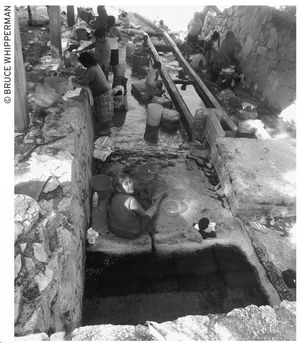
washing at the community agua caliente
By bus, get to Jalapa del Marqués via either the Tehuántepec central bus terminal or a second-class bus from the parking lot across the highway from the Tehuántepec town entrance street, Calle 5 de Mayo, by the market.
Tequisistlán
This little municipio, officially Santa María Magdalena Tequisistlán, was on ground too high to get gobbled up by the reservoir. Consequently, the huge-in-summer (and muddy) Río Tequisistlán continues to run right next to town. During the dry, hot spring this river appears very inviting for a dip into its clear, gurgling water.
Take a look inside the old church in the center of town. Here, folks enjoy the church’s completely marble-floored atrium in front, especially handy for dancing during the July 20–24 festival in honor of Santa María Magdalena. On the church’s side, you’ll find the kicker: probably the world’s only marble basketball court.
You can see the source of all this by going to the community marble factory (Empresa Comunal Industrial de Marmol y Onix, Hwy. 190, local cell tel. 044-995/101-8181, 8 A.M.–2 P.M. Mon.–Fri., 8–11:30 A.M. Sat.), about two kilometers (1.2 mi) west (Oaxaca City direction) of the town highway crossing. If you arrive during working hours, ask someone to “please show” (“favor de maestrar”) you around. You’ll see dozens of men and machines working beneath a shady open-air roof, cutting, grinding, and polishing dozens of beautiful pieces of marble and onyx.
In the factory office, feast your eyes on the beautifully polished finished products. They will custom-make most anything you want—such as the lovely marble bathroom vanity top you’ve always wanted, a statuesque marble cat, or some other favorite animal.
Get there by car, via Highway 190 (50 km/30 mi) in the Oaxaca City direction, or an hour by bus from the Tehuántepec bus terminal or parking lot. Get off at the Tequisistlán crossing and walk or taxi to the factory and/or the marble basketball court.
Juchitán and Vicinity
Isthmus people associate the name Juchitán with both the town, Juchitán de Zaragoza, and the governmental district that it heads—a domain larger in extent than either the Distrito Federal or each of the four smallest Mexican states. The district of Juchitán (Place of Flowers) ranges from the Chimalapa, the roadless jungle refuge of dozens of Mexico’s endangered species, south to the warm Pacific and the rich lagoons that border it.
But like any empire, Juchitán is the sum of its small parts—hidden slices of Mexico that few outsiders know, from the crystalline springs of Tlacotepec and Laollaga to the seemingly endless groves of the “world mango capital” at Zanatepec and the vibrant market and near-continuous community festivals—velas—of busy, prosperous Juchitán de Zaragoza.
Orientation
Juchitán (pop. 80,000) bustles with commerce all the daylight and early-evening hours. Main streets 16 de Septiembre and 5 de Septiembre steadily conduct a double stream of traffic to and from the north-side Highway 200 crossing. A few blocks to the west, the Río Los Perros (River of the Dogs, for the otters that hunt fish in the river) courses lazily southward, marking downtown Juchitán’s western boundary. Traffic focuses about two kilometers (1.2 mi) south of the highway at the town plaza, the Jardín Central Benito Juárez, the town’s commercial and governmental nucleus. On Calle 16 de Septiembre, on the plaza’s east side, the long white classical arcade of the palacio municipal fills the entire block, from Calle Efrain Gómez bordering the plaza’s north edge to Calle Benito Juárez on the south. Governmental offices occupy the upper floor of the palacio municipal, while businesses, crafts booths, and food stalls spread across the bottom. Behind the facade, taking up the entire city block east of the plaza, is the town market, Mercado 5 de Septiembre.
SIGHTS
 Around the Juchitán Plaza
Around the Juchitán Plaza
A fun spot to start off (or end) your day exploring Juchitán is at a table in the graceful old-Mexico patio of Restaurant Casa Grande (Calle Benito Juárez, 7 A.M.–11 P.M. daily) on the plaza’s south side. Here, a hearty breakfast or a cool lunch will invigorate you for yet another few hours of relaxed plaza sightseeing.
Stroll out and admire the fine busts of Benito Juárez on the plaza’s east side and Margarita Maza, his wife, on the west side, by Calle 5 de Septiembre. On the plaza’s north side, find the Monument to the Battle of September 5, 1866, where a Mexican eagle and a heroic Benito Juárez commemorate the victory of the ragtag local battalion over a superior French imperial force.
Step east, across Calle 16 de Septiembre, to the crafts stalls beneath the northerly (left) half of the presidencia municipal arcade. What you don’t find downstairs you’ll find in an upstairs market foyer. Stroll the aisles and choose from a host of excellent items customarily including, besides the famous Isthmus embroidered skirts and blouses, handwoven hamacas (hammocks); leather huaraches and bolsas (purses); woven palm tenates and reed canastas (baskets), petates (mats), and sombreros; and gold-filigree joyería (jewelry). You can also find much of the same (besides a riot of flowers) at many of the stalls that line the plaza’s north end.
For pottery, walk west along Calle Benito Juárez (which borders the plaza’s south side) to the block just west of the plaza. There, along the old town church’s rear wall, a lineup of stalls offers an assortment of ceramics, mostly practical traditional housewares, from huge round red ollas (jars) and flat comales (griddles) to brightly painted piggy banks and flower vases.
Templo de San Vicente Ferrer and Casa de la Cultura
While you’re in the vicinity, visit the town’s pride, the San Vicente Ferrer church. Reach it by circling the block: Continue west on Calle Benito Juárez, go immediately left at 5 de Mayo, then after one block turn left again at Belisario Domínguez, to the church on the left. Although the church’s early history is shrouded in mystery, the present construction appears by its style to date from the mid-19th century. Its dedication to San Vicente Ferrer, patron of survivors of the sea, appears connected to Juchitán’s original founding as a refuge for survivors, perhaps of some ocean disaster, such as a terrible tsunami or hurricane, some time shortly before the conquest. Present-day Juchitecos, inheritors of their patron’s zeal and ferocity, celebrate his memory with gusto to match, with no less than eight consecutive velas, beginning on the first Saturday of the last 15 days of May.
Across the street from the church, you might linger for a few minutes in the shady side plaza, Parque Helidoro Charis Castro. Here stands the bronze bust of Castro, the beloved Juchitecan maderista general who led the 13th Juchitecan Battalion in its bloody, but ultimately successful, revolt against dictatorial forces, from 1910 to 1914.
Afterward, look around inside the Casa de la Cultura (tel. 971/711-4589, casacult_istmo5@hotmail.com, 9 A.M.–2 P.M. and 5–8 P.M. Mon.–Fri., 9 A.M.–2 P.M. Sat.), next door, west of the church. The building, originally a Catholic school, became the Casa de la Cultura in 1972 through the efforts of celebrated Oaxaca painter Francisco Toledo. Rooms around the graceful, old-Mexico patio accommodate a café, a small archaeological museum, an art exposition gallery, and a children’s library. The reception staff sells a few Spanish-language books of local history and folklore and folk music CDs.
 The Women Warriors
The Women Warriors
As an interesting downtown side-street diversion, cross over the Río Los Perros for a look at the intriguing Women Warriors sculptures on the west riverbank. Head west along Calle Benito Juárez. Two blocks west of the plaza, from the middle of the river bridge, notice the two tall sculptures of women (in Juchiteca skirts and blouses, of course), about two stories high, in what appears to be a small neighborhood park.
Few local residents seem to know much about them, except that “they are guarding the people from the river.” (Although one person did tell me that they were erected by noted sculptor and lover of Juchitán, Miguel Urban.) Get a better view of the sculptures (which, close-up, you’ll see are of stainless sheet steel) by accessing the west riverbank from the pedestrian bridge a block upstream (north) from Benito Juárez.
The riverbank is especially pleasant around sunset, when, standing on the Benito Juárez bridge, you might catch a cooling breeze, enjoy the sky colors, and be entertained by the flocks of black grackles flying overhead and scrapping and cackling in riverbank trees as they settle down for the night.
ACCOMMODATIONS
Under $25
For a good downtown budget option, check out the 27-room Hotel Victoria (2 de Abril 29, tel. 971/711-1558, $17 s or d one bed, $19 d two beds with fan; add $5 for a/c) a block east and a block north of the town plaza’s northeast corner. What you see is what you get: plain but clean rooms with private, hot-water shower-baths. It’s best to arrive by early afternoon or book this hotel, a popular overnight for market vendors, a day in advance.
$25–50
Moving two blocks north from the plaza along 5 de Septiembre, past Miguel Hidalgo, you’ll find the welcoming Hotel Don Alex Lena Real (16 de Septiembre 48, tel. 971/711-1064 or 971/711-0989, fax 971/711-1064, hote-donalex@hotmail.com, $34 s, $40 d). The 14 very clean rooms with a choice of one king-size or a pair of double beds, come with air-conditioning, phone, cable TV, wireless Internet, and credit cards accepted.
Continuing north, about five blocks from the plaza, find the Hotel Don Alex’s sister hotel, the semi-deluxe Hotel López Lena Palace (16 de Septiembre 70, tel. 971/711-1388, fax 971/711-1389, hotellopezlena_reservaciones@hotmail.es, www.hotelesdeoaxaca.com, $40 s, $50 d, $60 t). Builders have included a modicum of extras, such as potted plants, airy staircases, and light, rose-tinted hallways, into the four-story building. The 40 comfortable rooms are tiled, very clean, and attractively decorated. Amenities include cable TV, wireless Internet, phones, air-conditioning, a bar, and a reliable restaurant; credit cards are accepted.
Over $50
Juchitán’s most relaxing hotel is the resort-style  Gran Hotel Santo Domingo (Crucero, Hwy. 200, tel./fax 971/711-1050, 971/711-3642, or 971/711-1959, hsto@prodigy.net.mx, www.hotelesdeoaxaca.com, $38 s, $52 d, $65 t), on the highway across from both the bus station and the ingress road to town. The Gran Hotel’s choice attraction is an invitingly large and luxurious pool and grassy patio, a welcome refuge for winding down from the heat and bustle. The approximately 60 rooms in a pair of long, double-storied tiers beyond a tropical entrance foyer, are spare but clean, spacious, high-ceilinged, and comfortable, with modern-standard bathrooms, air-conditioning, TV, phones, a good restaurant, parking, and credit cards accepted.
Gran Hotel Santo Domingo (Crucero, Hwy. 200, tel./fax 971/711-1050, 971/711-3642, or 971/711-1959, hsto@prodigy.net.mx, www.hotelesdeoaxaca.com, $38 s, $52 d, $65 t), on the highway across from both the bus station and the ingress road to town. The Gran Hotel’s choice attraction is an invitingly large and luxurious pool and grassy patio, a welcome refuge for winding down from the heat and bustle. The approximately 60 rooms in a pair of long, double-storied tiers beyond a tropical entrance foyer, are spare but clean, spacious, high-ceilinged, and comfortable, with modern-standard bathrooms, air-conditioning, TV, phones, a good restaurant, parking, and credit cards accepted.
FOOD
Juchitán’s downtown plaza food stalls do big business all day and half the night. Especially popular with local people are the market fondas (food stalls) at the bottom level, at the south (right) side of the palacio municipal. Another, more tranquil fonda spot is on the side plaza Helidoro Charis Castro, a block south of the main plaza, in front of the San Vicente Ferrer church.
Try the freshly baked offerings of the Panadería Internacional (Efraim Góez, between 8 de Septiembre and 16 de. Septiembre, 9 A.M.–9 P.M. Mon.–Sat., 9 A.M.–3 P.M. Sun.), half a block north of the plaza.
For a snack (sandwich, pizza, salad) and delicious espresso coffee there is soft-seat, 21st-century hip Italian Coffee Company (corner of 15 de Septiembre and Hidalgo, tel. 971/711-0773, 9 A.M.–10 P.M. daily, $2–5).
The pizza is hot, the spaghetti is tasty, and the salads are crisp at the Pizzería Gato Montes (Wildcat Pizza; Colón 7, tel. 971/711-3945, 5 P.M.–midnight daily, $3–9). Add movies (starting around 7 P.M.) and your evening will be complete. It’s located a block west of the San Vicente Ferrer church, between Belisario Domínguez and Juárez.
See VELAS: FIESTAS OF THE ISTHMUS
The class-act plaza-front restaurant, fine for a midday break, is the refined  Restaurant Casa Grande (Benito Juárez 12, tel. 971/711-3460, 7 A.M.–11 P.M. daily, $6–12) in the inner patio of an ex-mansion. The mostly business and upper-class patrons choose from an international menu of soups, salads, sandwiches, meats, and pastas, and a number of Oaxacan regional specialties, such as pechuga de pollo zapoteca (breast of chicken, Zapotec style), enchiladas de mole negro (enchiladas with black mole sauce), and chile relleno de picadillo (chili pepper stuffed with spiced meat); credit cards are accepted.
Restaurant Casa Grande (Benito Juárez 12, tel. 971/711-3460, 7 A.M.–11 P.M. daily, $6–12) in the inner patio of an ex-mansion. The mostly business and upper-class patrons choose from an international menu of soups, salads, sandwiches, meats, and pastas, and a number of Oaxacan regional specialties, such as pechuga de pollo zapoteca (breast of chicken, Zapotec style), enchiladas de mole negro (enchiladas with black mole sauce), and chile relleno de picadillo (chili pepper stuffed with spiced meat); credit cards are accepted.
On the other hand, local fish lovers frequent seafood restaurant Mariscos del Mar (corner of 16 de Septiembre and Hidalgo, no phone, 8:30 A.M.–7 P.M. daily, $3–8), one block north of the plaza, for its long, very correctly Mexican menu of seafood and more. Have it all, including a plethora of clam, oyster, and shrimp cocktails; seafood soups, both clear and creamed; fish, octopus, squid, lobster, and shrimp (cooked 10 ways); and seven styles of cucarachas (small prawns).
For good food in a Mexican Bohemian–style atmosphere, check out Restaurant Los Novios (The Sweethearts; 5 de Septiembre, tel. 971/712-0555, 7:30 A.M.–5:30 P.M. daily, $4–6), on a block north of the plaza, just past the corner of Hidalgo. Amidst a colorful gallery of the owners’ new-Impressionist-mode art, select from an innovative menu of breakfasts (freshly squeezed orange juice and hotcakes with bacon), spaghetti, and fowl (breast of chicken with chipotle sauce).
Alternatively, escape temporarily from Mexico to the coffee shop–style Restaurant Santa Fe (Hwy. 200, tel. 971/711-1545, 7 A.M.–midnight daily, $4–10), at the Highway 200 crossing, across from the Gran Hotel Santo Domingo. In the air-conditioned 1970s-mod atmosphere, enjoy fresh coffee and fruit, followed by tasty eggs, waffles, or pancakes for breakfast; several hamburgers and salads for lunch; and, finally, soups, spaghetti, beef, chicken, and fish for dinner. Credit cards are accepted.
FESTIVALS AND ENTERTAINMENT
Juchitán’s substantial excess wealth goes largely to finance an impressive round of parties, locally called velas, in honor of a patron saint or a historically or commercially important event. The velas are organized and financed by entire barrios, and led by mayordomos, usually a well-to-do male head of household, but also including his spouse, children, and all relatives and friends, who usually add up to a major fraction of the population of an entire Juchitán barrio. The mayordomo family, together with male and female capitanes and their closest friends, make up the mayordomía, the core committee responsible for carrying off the celebration.
Customary activities include blossom-decorated church masses, parties in the house of the mayordomo, community barbecues, a parade of fruit and flower-laden floats, from which the capitanas, dressed like brides in their stunningly embroidered Tehuántepec outfits, throw fruit and gifts to the street-side crowds.
(Note: Although the velas are local affairs, everyone is invited, and can join the fun by paying a nominal entrance fee, customarily $5–10 per adult.)
In all, Juchitecos celebrate 20 in-town velas, which fill streets with merrymakers during the last half of April, virtually the entire month of May, and several days each in June, July, August, and September—a total of about 50 days of celebrating for the entire year. This wouldn’t be too excessive if it were not for the approximately 20 obligatory national holidays and the other 30 not-to-be-missed velas in neighboring Isthmus communities.
Local folks sometimes offer droll commentaries about all this celebrating: “If you go to a mayordomo house, I’ll tell you what you’ll find…no bed, no stove, no shoes, just happy people and lots of friends.”
Lacking a local fiesta, you might want to take in a film at the genteel art Cinema Casa Grande (on the plaza, south side, tel. 971-711/0980, mid- to late afternoons Tues.–Sun.). Enter past the patio Restaurant Casa Grande (Benito Juárez 12). Or, alternatively, check out the evening entertainment, beginning around 7 P.M., at the Pizzería Gato Montes (Wildcat Pizza; Colón 7, tel. 971/711-3945, 5 P.M.–midnight).
As much a night club as it is a restaurant, the Restaurant-Bar Las Galias (Efrain Gómez 15B, dinner entrées $9–12) entertains guests with live Latin music, after 9 P.M. Friday and Saturday nights. Arrive early for fish, chicken, or a good steak, then dance the night away.
INFORMATION AND SERVICES
Tourist Information
The most reliable local government tourism office is in Tehuántepec: Turismo office (on Hwy. 200 south, Salina Cruz direction, no phone, 9 A.M.–7 P.M. daily), overlooking the Río Tehuántepec, two blocks west and two blocks south of the town plaza, before the river bridge.
Alternatively, in Juchitán, try travel agent Zarymar (5 de Septiembre 100B, tel. 971/711-2867), several blocks north of the plaza, for information, airline tickets, and car rentals.
Health and Emergencies
A ready source ofnonprescription medicines and drugs is the 24-hour Farmacia 24 Horas (corner of Efrain Gómez and 2 de Abril, tel. 971/711-0316), one block behind the north side of the presidencia municipal. Alternatively, go to Farmacia Similares (José F. Gomes, at the corner of 5 de Septiembre, tel. 971/711-3126, 9 A.M.–10 P.M. daily), a block south of the plaza’s southwest corner.
A number of doctors maintain offices near the plaza. For example, general physician–sur-geons Dr. Ruben Calvo López and Dr. Carlos Alonso Ruiz and gynecologist Doctora Anabel López Ruiz hold regular consulting hours at Clínica San Fernando (16 de Septiembre, between Efrain Gómez and Hidalgo, tel. 971/711-1569), half a block north of the plaza’s northeast corner.
Alternatively, go to the Clínica Nuestra Señora de Exaltación (5 de Septiembre, east side, tel. 971/711-0204), with a very professional pharmacy, half a block north of the plaza. Here, general practitioner Doctor Guillermo Gonzales and gynecologist Doctora Catalina Martínez partner with several other medical specialists on call.
In a medical emergency, follow your hotel’s recommendation or hire a taxi to the General Hospital Dr. Macedonio Benítez Fuentes (Efrain Gómez, tel. 971/711-1441 or 971/711-1985), downtown, near the plaza.
In case of police or fire emergency, dial 066, the public crisis number.
Money
A number of downtown banks, which all have ATMs, help manage Juchitecos’ money. They’ll also change your money into pesos or U.S. dollars. A good bet is Banorte (Efrain Gómez 19, tel. 971/711-1160 or 971/711-3482, 9 A.M.–4 P.M. Mon.–Fri., 10 A.M.–2 P.M. Sat.), half a block west of the plaza’s northwest corner. Second choice goes to Banco Santander Serfin (corner of Belasario Domínguez and José F. Gomes, tel./fax 971/711-2000, 9 A.M.–4 P.M. Mon.–Fri.), a block south of the plaza.
Communications
The correo (tel. 971/711-1272, 8 A.M.–7 P.M. Mon.–Fri., 9 A.M.–noon Sat.) is at the plaza’s northeast corner, just west of the presidencia municipal. For a public fax or a money order, go to the telecomunicaciones (on Aldama, four blocks west of 16 de Septiembre, 8 A.M.–7 P.M. Mon.–Fri., 9 A.M.–noon Sat.).
Internet access is available at Spider Net (Efrain Gómez, no phone, 9 A.M.–10 P.M. daily), a few doors east of 5 de Mayo.
GETTING THERE AND AWAY
By Bus
A modern long-distance camionera central (central bus station), at the Highway 190-200 crossing north of downtown, is the point of departure for all of the first-class and most of the second-class bus connections with both Oaxaca and national destinations. First- and second-class lines service customers from separate waiting rooms (first-class on the left, second-class on the right). The busy but clean station has snack stores and luggage-check service. Long-distance telephone and fax is available at a small office in the second-class waiting room.
Autobuses del Oriente (ADO; tel. 971/711-2565 or 971/711-1022) and affiliated lines offer direct first-class connections north with Gulf of Mexico destinations Minatitlán, Coatzacoalcos, Villahermosa, Palenque, Merida, Cancun, and Tulum; and northwest with Oaxaca City, Mexico City, Veracruz, and Tampico. Additionally, first-class carrier Omnibus Cristóbal Colón (OCC; tel. 971/711-2565) and its luxury-class subsidiary, Plus, offer connections northwest with Oaxaca City, Puebla, Mexico City, and Veracruz; southwest with Salina Cruz, Bahías de Huatulco, Pochutla (Puerto Ángel), and Puerto Escondido; and east with Chiapas destinations of Tuxtla Gutiérrez, San Cristóbal las Casas, and Tapachula, at the Guatemala border.
Second-class carriers include Autobuses del Oriente (ADO), which offers connections north with Coatzacoalcos; southwest with Tehuántepec and Salina Cruz; and east with Tapanatepec, including all intermediate destinations. Additionally, Autobuses Unidos (AU) offers second-class connections northwest with Tuxtepec, Puebla, Mexico City, Orizaba, and Veracruz; and southwest with Tehuántepec and Salina Cruz, including many intermediate destinations. Moreover, Sur offers second-class connections north with Coatzacoalcos; northwest with Oaxaca City; southwest with Bahías de Huatulco; and east with Tapanatepec and Tapachula, including intermediate destinations.
Semi-local bus connections with adjacent towns are available via the Autotransportes Istmeños buses across the side street, south, less than a block toward town from the camionera central.
Mostly second-class Fletes y Pasajes buses operate out of a separate terminal, also at the Highway 190-200 crossing but on the west side, adjacent to the Restaurant Santa Fe. Buses connect east with Chiapas destinations of Tuxtla Gutiérrez, Tapachula, and the Guatemala border; northwest, with Oaxaca City, Puebla, and Mexico City; and north with Tuxtepec and Minatitlán.
By Car
Drivers have the same highway choices and destinations as they do for Tehuántepec. Simply subtract 30 minutes driving time (and 27 km/17 mi distance) for northerly and easterly trips; and add the same for northwesterly and southwesterly trips. In Juchitán, fill up with gasoline at the Pemex gasolinera at the Highway 190-200 town ingress crossing, next to the bus station.
North of Juchitán
A number of uniquely interesting destinations await travelers willing to venture into the foothill hinterland northwest and north of Juchitán. Foremost among them are the storied former royal Zapotec bathing springs that well up, blue and crystalline, at Tlacotepec and Laollaga, an hour’s travel northwest of Juchitán.
Equally ripe for exploring is the stalactite-studded limestone cave near the town of Santo Domingo Petapa, together with the singularly successful cooperative company town at Lagunas, about 1.5 hours north of Juchitán.
Each of these excursions can be enjoyed from Juchitán in a leisurely day by car or a long day by bus.
THE SPRINGS AT TLACOTEPEC AND LAOLLAGA
Both of these bathing resorts were part of the territory of the Zapotec royal family of King Cosijoeza. He often used the springs as a refuge during his protracted war with Aztec emperor Ahuitzotl during the 1490s. A famous traditional story recounts how love resolved the bloody conflict. Tiring of the struggle, Ahuitzotl proposed a peace pact. In exchange for allowing Aztec traders and envoys to pass through the Isthmus lands, Cosijoeza would receive Aztec princess Coyollicatzin in marriage. One day, meditating over the proposition while bathing in the Tlacotepec spring, Cosijoeza was awestruck by a stunning apparition of Coyollicatzin. Despite his apprehension, Coyollicatzin’s apparition enchanted him with her beauty. Thus persuaded, Cosijoeza soon took Coyollicatzin in marriage, sealing the pact between the two nations.
Their marriage was a happy one. Children resulted, and Cosijoeza passed the springs at Tlacotepec and Laollaga to their son Cosijopí, the king of the Isthmus lands, and their daughter, Princess Donaji, both of whom continued to exercise authority after the conquest.
 Balneario Tlacotepec
Balneario Tlacotepec
Storied Princess Donaji, who after the conquest was baptized as Magdalena Donaji, donated both her Christian name and the springs and royal park at Tlacotepec to the local community, still known as Magdalena Tlacotepec.
Today, the town’s springs and surrounding sanctuary are a unique asset for all istmeño families to enjoy, which they do en masse on sunny Sundays and holidays. The source, a clear, cool underground river, wells up from a rocky basin and fills a long, meandering, aqua-blue swimming hole. Shoals of little fish that nibble and tickle your feet hide in crannies and flit along the sandy bottom. Shady mango trees overhang the bank and spread over a rustic public strolling ground on one side. On the other, the entrance side, food stalls surround a parking area.
Here you can park your (self-contained) trailer or RV or set up a tent and stay a spell, walking into the surrounding hills in the morning to enjoy wildlife and wildflowers and splashing in the cool spring in the afternoons. Custodial personnel, who keep the site clean and secure, collect nominal fees for parking and camping.
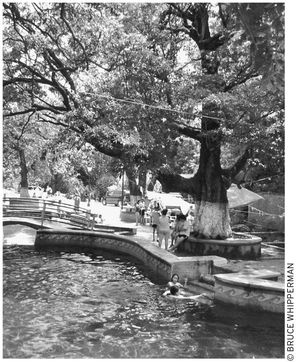
Balneario Tlacotepec, once a playground for the Tehuántepec nobility
Santiago Laollaga
Laollaga (lah-oh-YAH-gah) springs mark the northern boundary of the petite municipio of Santiago Laollaga, which you pass through on your way to the springs. A big parking lot overlooks the main series of pools (concrete basins) built into the rocky downhill channel of the Río Laollaga. Shady trees overhang the pools, and a pair of permanent open-air comedores on the riverbank serve drinks and food.
Visitors equipped with a self-contained trailer or RV might enjoy a stay, parking in the lot for a day or two. Fees run only a few dollars a day. Unfortunately, the water at the main pools is sometimes a bit tainted by soap from folks washing clothes upstream. You can assure pure water by following the river 0.5 kilometers (0.3 mi) upstream to its source, a natural ojo de agua spring welling from the base of the hills. Here, great shady trees spread over a sandy riverbank, ripe for tent camping if you don’t mind sharing the spot with a few townsfolk on weekdays, and more on weekends.
Laollaga diversions might include strolls around the town and along dirt roads and trails, into the summer-lush native tropical woodlands. By local bus or car, you could explore farther afield, along the good gravel road (at the northeast corner of town, where you made your last turn left) threading the green-forested Río Los Perros valley and foothill country 25 kilometers (15 mi) northwest to remote Santa María Guienagati.
Arrive during the last 10 days in July and join Laollaga’s big Fiesta de Santiago Apóstol (July 20–30), which includes four separate velas, with fireworks, carnival rides and games, regada (fruit-throwing), dances, and mojigangos (giant dancing figures).
Small town stores can supply basic groceries. Pharmacies, a private doctor, a centro de salud, a post office, and a caseta larga distancia can provide essential services.
Getting There
Get to Tlacotepec and Laollaga from Juchitán via Ixtepec, half an hour north of Juchitán. The easiest and cheapest way to go is by one of the Ixtepec-labeled local buses that frequently head north from the Highway 190 crossing in Juchitán, across the street from the main bus station and the gas station. Half an hour later, at Ixtepec, transfer to the blue-and-white Tlacotepec- or Laollaga-labeled local bus.
It’s more complicated, but possible, to make your way by car. From the Highway 190-200 crossing at Juchitán, mark your odometer and head north across Highway 190-200, continuing through Ixtaltepec (eight km/five mi) to the railroad tracks at Ixtepec (15.6 km/9.7 mi). Immediately after crossing the tracks, turn left. After one block, turn right at Ixtepec’s main street, Calle 16 de Septiembre. Continue five blocks (0.5 km/0.3 mi) and turn left (west) at Galeana (16.1 km/10 mi). Continue west; follow the curve right after about a mile, then after two blocks, at the police post on the right, curve left. Continue about another mile, and at a Y-intersection (19.2 km/11.9 mi) go left and continue, following the Balneario signs to the Tlacotepec springs, a total of about 29 kilometers (18 mi).
Alternatively, for Laollaga, bear right at the abovementioned Y intersection and continue through Chihuitán (turn left at the village corner, at 26.1 km/16.2 mi) to Santiago Laollaga village center (31 km/19.2 mi). Turn right and continue a block, pass over a bridge, and, a block or two farther, at the presidencia municipal, turn left. Continue half a mile to the Ojo de Agua sign, turn left and continue to the balneario entrance after about three blocks. If you get lost, ask a shopkeeper (or point to this in your guide): “¿Donde está El Balneario Laollaga?” (dohn-DAY ays-TAH AYL bal-nee-AH-reeoh lah-oh-YAH-gah?). “Where is the Balneario Laollaga?”
LAGUNAS: COMPANY TOWN
If success can be measured by longevity, the industrial cooperative town of Lagunas, which began producing cement in 1942, has earned its plaudits. Moreover, the unique experiment it represents seems as robust as ever. The idea began back in the 1930s, when investors were eager to exploit a mountain of local limestone that towered conveniently beside the cross-isthmus rail line. The era was, however, that of reformist President Lázaro Cárdenas, when the star of socialism was rising over Mexico from the east. The enterprise must be a cooperative, the government demanded. Investors, realizing the project’s unique prospects, agreed, and Cruz Azul, a uniquely Mexican private-public cooperative, was born.
Today, the great mill beside the railroad tracks hums all day and night, producing millions of tons of cement yearly for projects from Chile to Canada. Moreover, besides supporting the livelihoods of thousands of families in the entire local hinterland, the Lagunas mill (judging from the tidy, dust-free town) appears to produce little of the cement dust that has debilitated cement-mill workers, especially in third-world countries, all over the globe.
At the town center, across the tracks from the mill, a monument erected by the workers (the Cooperadores de La Cruz Azul) honors Guillermo Alvarez, Cruz Azul’s guiding light, with a pair of eternally flickering electric lamps.
Along Avenida Cooperativismo, facing the plant stand the town Banamex branch, the correo, telecomunicaciones, and the plant superintendent’s office. Badged workers, all in pressed khakis and hard hats, walk with purpose along the sidewalks. Some turn and continue along the town’s main street, Avenida Cruz Azul, and continue past the hamburger shop, centro comercial (company store), an immaculate bakery, and the big church, dedicated to the Virgin of Guadalupe. From the commercial center, tree-lined residential streets extend past schools, a hospital, and tidy concrete houses with some of Mexico’s rare, American-style unfenced yards with lawns.
SANTO DOMINGO PETAPA: LIMESTONE CAVE
Several miles past Lagunas, Santo Domingo Petapa (pop. 2,000) marks the end of the pavement. Unless you arrive during a national holiday or the August 1–4 town festival in honor of Santo Domingo, Petapa will appear as a typical sleepy Oaxaca country town. Petapa does have, however, at least one claim to fame, and that is the grand limestone cavern on the mountainside three kilometers (two mi) beyond the town.
You will need both local permission and a local guide. The most highly recommended is locally experienced Ismael Juárez.
Lacking prior arrangement, the best procedure would be to arrive early (say by 10 A.M.) on a weekday and inquire for a guide at the presidencia municipal. You could smooth all this along by writing a letter, weeks in advance, in Spanish, addressed to the Presidente Municipal, Santo Domingo Petapa, Oaxaca, 70350, telling your date and time of arrival and that you’d be happy to pay for an experienced guide to show you the cave.
Such preparations will give you a good chance of seeing the inside of the cave. Come equipped with sturdy shoes, hard hats (at least plastic), and, if possible, super-bright three- or four-celled flashlights. The cave, 1–2 hours’ walk west of town, is large, with a towering, cathedral-like entry portal and a river flowing from its mouth. Your exploration inside will take at least two hours and extend past stalagmites and stalactites approximately one kilometer (0.6 mi) into the mountainside.
East of Juchitán
From south to north, the grand Isthmus landscape east of Juchitán gradually changes through three distinctive panoramas. In the south, at the Pacific Ocean, the Isthmus begins as three grand, glassy lagoons, the Laguna Superior and Inferior on the west side and the Mar Muerto (“Dead Sea”) on the east. This is the home ground of the Huave people, driven to the Isthmus’s salty edge an age ago by the Zapotecs, to make their living mostly from the sea. North of that lies the fertile, most prized crescent of pastures, fields, and orchards of the sizable towns of Niltepec, Zanatepec, and Tapanatepec, beside the Pan-American Highway, which connects them all. Farther north rise the trans-isthmus mountains, the Sierra Atravesada, heartland of the Chimalapa, a wild kingdom of sylvan forests, rushing rivers, and deep, shadowed canyons, a final refuge of rare, endangered, and yet-to-be-discovered species of plants and animals.
First access to all this is by the Pan-American Highway 190-200 east of Juchitán, then by side roads north and south from junctions such as La Venta, Zanatepec, and Tapanatepec.
LA VENTA
La Venta (The Windy Place), about 29 kilometers (18 mi) east of Juchitán, lives up to its name. So much so, that the Comisión Federal de Electricidad harnesses the wind’s energy with a farm of giant, ultramodern windmills, visible astride Highway 185 for miles, obediently generating many millions of kilowatts for southern Mexico’s homes, businesses, and factories.
Get to La Venta by eastbound ADO, Cristóbal Colón, or Sur bus, from either of the central terminals at Tehuántepec or Juchitán. Drivers: Simply head west half an hour along Highway 190-200 to La Venta, at the Highway 185 junction.
The Chimalapa
A rough but mostly paved side road leads north from La Venta to the backcountry Chimalapa jumping-off point villages of San Miguel Chimalapa (23 km/14 mi) and Cuauhtémoc (27 km/17 mi). The immense million-acre Chimalapa de facto wilderness is the communal property of two Zoque-speaking indigenous communities headquartered, respectively, at San Miguel Chimalapa and the more remote San Martín Chimalapa, 48 rough kilometers (30 mi) north from the Highway 185 junction at El Mezquite.
The Chimalapa Zoque people are rightly suspicious of strangers, especially now that their lands have become one of Mexico’s few remaining storehouses of precious tropical hardwoods, endangered animals, and scarce minerals. Legitimate visitors to the Chimalapa wilderness, if any are allowed at all, are strictly licensed by state and local authorities and must be accompanied by community guides. If you’re interested in hiking and camping in the Chimalapa, first contact Oaxaca state tourism (703 Av. Juárez, tel./fax 951/516-0123, www.aoaxaca.com, info@aoaxaca.com, 8 A.M.–8 P.M. daily).
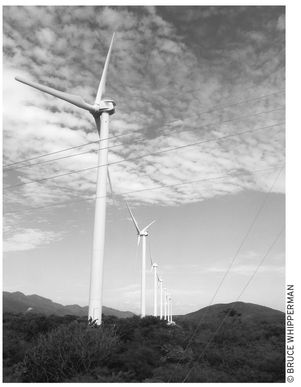
The gargantuan windmills of La Venta generate energy for southern Mexico.
PLAYA COPALITO AND SAN DIONISIO DEL MAR
For adventurous travelers, a side trip to the shoreline of the grand lagoons that form the Isthmus’s Pacific border will yield experiences and reveal scenes of a Mexico known by scant few Mexicans and even fewer foreign visitors. Get there by bus from Juchitán, first by taxi to the east side via the Unión Hidalgo bus station.
Your destination, Playa Copalito (Little Copal Tree Beach), is a tiny fishing village (but with electricity) of thatched houses and Huave-speaking people. A long, sandy beach built of myriad wave-washed mussel and clam shells winds along the oft mirror-smooth Laguna Superior. Motorboats and canoas (canoes) recline lazily on the beach. A few shoreline copal trees provide a bit of shade, and grassy (during the summer rainy season) spaces appear fine for RV parking or tent camping.
Here, the main work for locals and diversion for visitors is fishing. Lanchas routinely return with a dozen one- or two-pound lisa (mullet) and sierra (mackerel). Fisherfolk are willing to take visitors on a half-day fishing excursion or exploration for about $20.
Since Playa Copalito is an idyllic but isolated little place, campers should arrive well-equipped with tent, food, and water. Bring insect repellent; mosquitoes may be fierce certain times of the year (although they weren’t a problem one wet September). Moreover, security is good here, by virtue of the local naval detachment.
As for food, although a few village stores can supply some essentials, it’s best to be prepared with your own fresh fruits and vegetables. The homey palapa Restaurant Playa Copalita (8 A.M.–7 P.M. daily, $4–10) of the friendly Pinedo Castellanos family, a su servicio, will be happy to provide fresh fish dinners.
While you’re in the vicinity, the pilgrimage town of San Dionisio del Mar would certainly be worth a visit. The miraculous image of San Dionisio at the town church attracts thousands of pilgrims yearly, mostly for the October 6–10 festival. Things get started right away on October 6, when a carnival sets up and food stalls begin serving traditional atole (a nonalcoholic corn-juice drink) and tamales for the arriving pilgrims. The next day, the mayordomía officials crown the queen, while everyone enjoys a community dance and barbecue at the house of the mayordomo. Dances continue for the next two nights, punctuated by processions with fruit and gifts thrown to the celebrants, and nightly fireworks paint the sky red, blue, and green. A basic guesthouse, Casa de Huéspedes San Dionosio (at the southeast edge of the village, no phone, $5 pp, $15 pp during festival) is available for separate male and female dormitory accommodations, each with separate, shared tepid-water baths.
Getting There and Away
Get to Playa Copalita and San Dionisio del Mar via Unión de Hidalgo direct from Juchitán or La Venta. Bus travelers: Catch the bus direct to San Dionisio del Mar and Playa Copalita at the east-side Unión Hidalgo bus terminal (take a taxi), in Juchitán.
Drivers head east along Avenida 20 de Noviembre (from about 10 blocks north of the plaza), about a mile, passing over the railroad tracks and continuing about 11 kilometers (seven mi) to Unión de Hidalgo. In Unión de Hidalgo, turn right (south) at the Chicapa de Castro sign. Continue another three kilometers (two mi) to Chicapa de Castro. There, turn left in mid-village and continue southeast another 16 kilometers (10 mi) to Playa Copalita (turn right at the dirt road at the edge of San Dionisio del Mar) or San Dionisio del Mar (continue to the church, at the east end of town), a total of about 39 kilometers (24 mi) from Juchitán.
You can also get to Playa Copalita and San Dionisio del Mar by bus from La Venta. At La Venta, transfer to a local bus or colectivo going south half an hour to Unión de Hidalgo, then transfer to the bus bound for San Dionisio–Copalita, via Chicapa de Castro. About 45 bumpy minutes later, get off at the west edge of San Dionisio del Mar at the Playa Copalito right side road (walk about two km/1.2 mi) or continue ahead to San Dionisio del Mar.
From La Venta by car or RV, set your odometer as you head south from Highway 190-200 on the side road to Unión de Hidalgo. At 11.6 kilometers (7.2 mi), make your way through the town, asking townsfolk “¿El camino a Chicapa?” (“The way to Chicapa?”). Arrive at Chicapa del Castro (17.5 km/11 mi), where you turn left, heading southeast toward San Dionisio del Mar. After a total of 34.8 kilometers (21.6 mi), turn right at the edge of San Dionisio del Mar, at the dirt road to Playa Copalito (two km/1.2 mi farther), or continue into San Dionisio del Mar, a total of about 35 kilometers (22 mi), to the church at the east end of town.
SANTO DOMINGO ZANATEPEC
The key country town of Santo Domingo Zanatepec (pop. 10,000), on Highway 190-200 about 87 kilometers (54 mi) east of Juchitán, is the point of departure for the wild and spectacularly steep Zanatepec River Canyon. There, accompanied by a guide, you can bask in a warm spring and hike to a pair of wilderness lakes.
Zanatepec, moreover, has a restaurant and hotel. For a break, stop by the mango-shaded Restaurant Nadxielly (Hwy 190-200, tel. 994/721-0257, 7 A.M.–midnight daily, $5), where for a few pesos you can eat all the mangos you want in season during April and May. The family-run establishment, set back, but well marked on the highway’s north side, offers several breakfasts and good home-style comidas, such as pork chops en chipotle, or caldo de pollo (grandma’s chicken-vegetable soup).
Next door stands the beautifully renovated Hotel San Rafael (Santa Domingo Zanatepec, tel. 994/721-0257, $18 s, d, t with fan, $30 s, d, or t with a/c). The 20 rooms are comfortably furnished, in graceful old-Mexico style, with colorful tiles and handloomed bedspreads; wireless Internet and parking are included. Be sure to request a room that opens to the tranquil, leafy, rear inner garden patio.
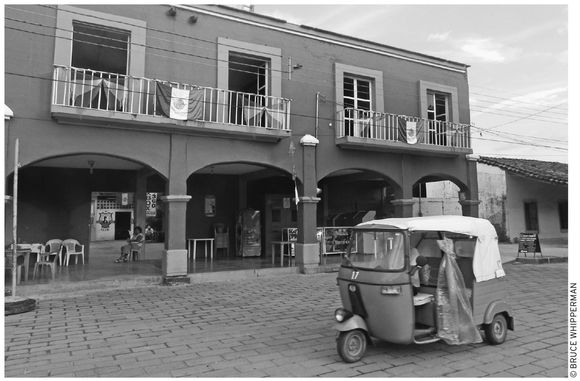
Zanatepec
Practicalities
Zanatepec services are located mostly along main street Hidalgo, which heads north, away, from the highway. Find groceries at Abarrotes Eli (Hidalgo, 8 A.M.–8 P.M. daily); doctors, such as Dr. Horacio Hernández (Hidalgo, 8 A.M.–2 P.M. and 4–6 P.M. Mon.–Sat.) two blocks before the plaza, or Dr. Luis Manuel Sáchez at his farmacia (Hidalgo, no phone, pharmacy: 8 A.M.–9 P.M. Mon.–Sat.; consultations: 9 A.M.–2 P.M. and 4–7 P.M. Mon.–Sat.); telecom (Hidalgo 200, tel. 994/721-0142, 9 A.M.–3:30 P.M. Mon.–Fri.) and correo (Hidalgo 200, no phone), both in the same building, next to the presidencia municipal; and policía (Hidalgo 198, tel. 994/721-0260) at the presidencia municipal.
The Canyon of the Río Zanatepec
The Hotel San Rafael (Santa Domingo Zanatepec, tel. 994/721-0257) also serves as contact point for guide Hermilo Toledo ($30 per day, including food), experienced at leading parties on excursions into the Río Zanatepec Canyon during the December–May dry season. (During the rainy season, the river will usually be too high.) Access from the highway is by a gravel road (that can include a stop at the village of Agua Caliente and its warm spring) to the trailhead (14 km/nine mi). Continue on foot (about two hours) up the canyon to a pair of small lakes, the Lago del Sol (Lake of the Sun) and Lago de la Luna (Lake of the Moon). Options include expert-level rock climbing, wildlife-viewing, fishing, and wilderness camping by the river or the lakes. Contact Hermilo Toledo through his brother, Manuel Toledo, who works at the Hotel San Rafael.
SAN PEDRO TAPANATEPEC
“Mango Capital of the World” San Pedro Tapanatepec (pop. 15,000), besides being the main access point for Rincón Juárez on the Mar Muerto, also has a number of hotels, restaurants, and services, both on the highway and in town, about four blocks south of the highway.
Accommodations and Food
A trio of acceptable country hotels offer lodging in Tapanatepec. The fanciest is the Hotel Casablanca (Calle Melendez, tel. 994/721-8039, $20 s, $24 d with fan, $26 s, $30 d with a/c) downtown, on the town plaza. The Casablanca offers about 10 comfortably furnished rooms, with private hot-water shower-baths. Find it in the main business district, about four blocks south of the highway.
Back on the highway, the second hotel choice goes to Hotel Misión (Hwy. 190-200 Km 924, tel. 994/721-8133 or 994/721-8009, $18 s, $20 d with fan, $25 s, $30 d with a/c). The approximately 35 basic bare-bulb but clean rooms are in a motel-style layout with parking spaces in front of units. All rooms have tepid-water shower-baths and cable TV; credit cards are not accepted. The hotel offers relief from highway truck noise if you get a room in the rear away from the highway.
Also acceptable, partly because of its good, longer-hours restaurant, is the Posada Flor (Hwy. 190-200 Km 924, tel. 994/721-8047, $13 s, $18 d with fan; $26 s, $33 d with a/c), across the highway, on the north side, from the Hotel Misión. The approximately 15 basic but clean rooms (by the truck-noisy highway, however, so use ear plugs) have tepid-water shower-baths, cable TV, and parking; credit cards are not accepted.
Any time other than the Fería del Mango (Mango Fair, first week of April) or the Fiesta Patronal de San Pedro (June 27–30), the hotels do not ordinarily require a reservation, provided you arrive before dark.
Groceries are conveniently available at markets on the highway, such as Abarrotes La Flor (Hwy. 190-200, tel. 994/721-8282, 8 A.M.–9 P.M. daily).
The first choice for a meal in Tapanatepec goes to the restaurant of the motel-style Posada Flor (on the north side of the highway, east end, Hwy. 190-200 Km 924, tel. 994/721-8047, 8 A.M.–10 P.M. daily, $4–10). The second choice goes to the similarly good restaurant at the Hotel Misión (Hwy. 190-200 Km 924, tel. 994/721-8133 or 994/721-8009, 8 A.M.–7 P.M. daily, $5–10).
Services
Most of Tapanatepec’s service establishments are along the main business street, Calle Martín Melendez, parallel and about four blocks south of the highway. For money, find Banamex (Martín Melendez 48, 9 A.M.–4 P.M. Mon.–Fri.) with ATM; for medicine, go to one of the pharmacies on the highway, or Farmacia Espinoza (Martín Melendez 78, tel. 994/721-8192, 7 A.M.–9 P.M. daily). A doctor is on duty 24 hours at the Seguro Social clinic (16 de Septiembre 47, tel. 994/721-8119).
For a telephone, use one of the card-operated public telephones (Ladatel cards widely purchasable) on the highway and downtown. The correo (Av. Juárez, tel. 994/721-8215, 9 A.M.–3 P.M. Mon.–Fri.) and telecomunicaciones (Av. Juárez, 9 A.M.–3 P.M. Mon.–Fri.) are both by the presidencia municipal (tel. 994/721-8160). Find the Policía Federal de Caminos (Federal Highway Patrol; tel. 994/721-8313) on the highway.
RINCÓN JUÁREZ AND THE MAR MUERTO
Adventurers might enjoy exploring what istmeños call the Mar Muerto, in contrast with what they call the Mar Vivo (the open ocean). Head out from Tapanatepec south about 23 kilometers (14 mi) by a good paved road to Rincón Juárez village (pop. 1,000). Three or four seafood palapas line a sandy beach, lapped by the gentle waves of a spreading, silvery sea. Life follows the drowsy rhythms of daylight and darkness, wind and tides. Early mornings, fisherfolk load their nets and paddle silently out in canoes or buzz out in motorboats to try their luck. Usually, they return with about a 20-pound catch, possibly including jumbo shrimp, clams, or fish for sale to the wholesalers whose trucks arrive in early afternoon.
Visitors also can take pleasure from their own quiet routine, enjoying sunrises and sunsets, watching the flocks of pelicans, cormorants, herons, and lovely flamingo-like roseate spoonbills, and exploring the lagoon either on foot or by boat. Fisherfolk are willing to take parties out for wildlife-viewing or fishing excursions (expect to pay about $40 for half a day). Be prepared with your own binoculars and fishing tackle. Alternatively, launch your own boat or inflated raft right on the beach.
The prettiest spot on the Rincón Juárez shoreline is on the eastern side, at palapa Restaurant Chabelita (9 A.M.–7 P.M. daily, $5–10) with good lisa (mullet) and shrimp lunches and dinners and affording a view of canoes slipping leisurely along the glassy water. If you’re planning on staying, it’s best to come supplied with fruits and vegetables and drinking water.
Unfortunately, however, despite its calm water, the Rincón Juárez immediate shoreline is useless for most beach diversions because the bottom is coated with muddy, oxygen-poor, black ooze, probably related to the reason that the local body of water is called the Mar Muerto.
Fortunately, there’s an alternative, at Colonia Guadalupe village, on the shoreline about a mile east (left as you face the water) from Rincón Juárez. There the sandy beach and lagoon floor are clean and welcoming, and you can kick back and enjoy the charms of the beach village, with a sprinkling of fisherfolks’ houses and shady palapas spread along a sandy spit. Offshore, seagulls and pelicans swoop and dive, and along the inland side lagoon hosts of cormorants, herons, and white ibis stalk, cackle, and preen.
The best spot seems to be Balneario Playa Sol, with a sandy, albeit narrow, beachfront, with a clean sandy bottom that extends at least a few hundred feet offshore. Meals are available in the Playa Sol’s palapa restaurant, there are hammocks in the shade, and a bit of space for tenting and self-contained RV parking. Ask if someone rents horses or can supply a canoa or motor lancha for a fishing excursion. With your own rubber boat, canoe, motorboat, or kayak you could explore the Mar Muerto to your heart’s content.
Other Practicalities
Back in Rincón Juárez, along the road in the middle of the village, on the right side as you enter town, Los Cocos, is a store providing both basic groceries and home-cooked comidas.
Tenting and RV camping promises to be fine anywhere along the local beach for the foreseeable future. Plenty of shoreline trees provide shade and convenient branches, fine for hammocks.
Get to Rincón Juárez by bus (Tapanatepec-bound first- or second-class) from either the Juchitán or Tehuántepec central terminals. At Tapanatepec, from the highway, continue south via colectivo ($6) to Rincón Juárez.
By car, the Rincón Juárez trip requires about two hours, one way, from Juchitán. Set your odometer at the Juchitán Highway 190-200 crossing by the Pemex gas station. Continue east along the highway about two hours to Tapanatepec. After a total of 108 kilometers (67 mi) (or 21 km/13 mi from Hotel San Rafael in Zanatepec), in the middle of Tapanatepec you reach the paved highway turnoff road for Rincón Juárez on the right. Continue through the town and over the only river-crossing bridge. Continue along another 23 kilometers (14 mi) of paved road to Rincón Juárez, a total of about 119 kilometers (74 mi) from Juchitán.
Salina Cruz and Vicinity
Salina Cruz was important long before the conquest. The salinas (salt-producing ponds), where untold generations of native folks had been harvesting salt for trade, attracted Hernán Cortés very soon after his arrival in Mexico. He also recognized Salina Cruz’s strategic position on the Isthmus, where the long-sought route to China was accessible, not by a torturous trans-Sierra journey but by a short, easy passage over the narrow, low Isthmus. Cortés lost no time in acquiring the salinas as part of his personal domain and building ships on nearby Playa La Ventosa with which to explore the Pacific.
His efforts have been amplified by successive generations. Beginning in the 19th century and continuing to the present day, the Isthmus regularly tempts canal builders wanting to carve a sea route between the Atlantic and Pacific. President Juárez’s government settled for a rail connection, begun by the American Louisiana railroad company in Salina Cruz around 1870. President Porfirio Díaz presided over the project’s climax, with up-to-date Salina Cruz port facilities built by the British company Iglesias, Pearson and Son, Ltd., around 1900.
Since the 1960s, Petróleos Mexicanos (Pemex) and other government authorities have greatly extended those early efforts with a hefty trans-isthmus pipeline funneling Gulf crude oil to a grand petrochemical complex as well as elaborate new shipping docks. From these, great loads of chemicals, crude oil, gasoline, and other fuels, minerals, fruit, and much more move out via truck, train, and ship to Mexico and the Pacific. Salina Cruz has thus become the industrial engine of the southern Mexican Pacific, employing more than 10,000 workers whose wages directly and indirectly support many tens of thousands more.
SIGHTS
Salina Cruz (pop. 80,000), Oaxaca’s third-largest city, outstrips both Juchitán and Tehuántepec in hustle and bustle. In Salina Cruz, enterprise reigns and people are working. Crowds with money to spend support a host of town-center markets, stores, offices, hotels, and restaurants. If you need to buy something, Salina Cruz is the place in the Isthmus where you’re most likely to get it.
Salina Cruz’s big downtown stretches in a two-kilometer (1.2 mi) rectangle north and south from the town plaza. Some of the north–south streets change names at the plaza, others don’t. On the plaza’s east side, 5 de Mayo becomes Héroes south of the plaza, while on the plaza’s west side, Avila Camacho retains the same name its entire length. West another block and north of the plaza runs Wilfredo Cruz, which becomes Tampico on the south side, while a block east of 5 de Mayo, Puerto Ángel remains the same both north and south of the plaza. Thankfully, east–west streets do not change names. From a block north of the plaza, moving successively south, are Guaymas, Mazatlán, Acapulco, and, finally, Coatzacoalcos, a block south of the plaza.
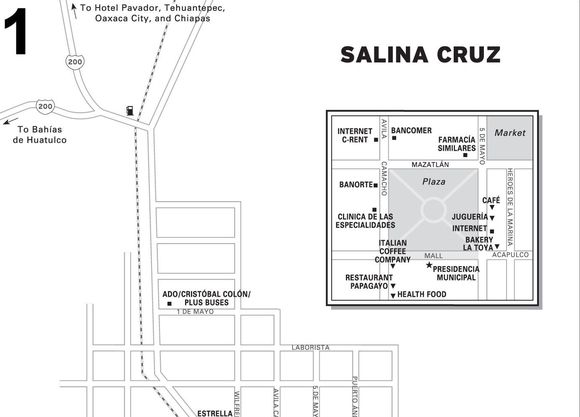
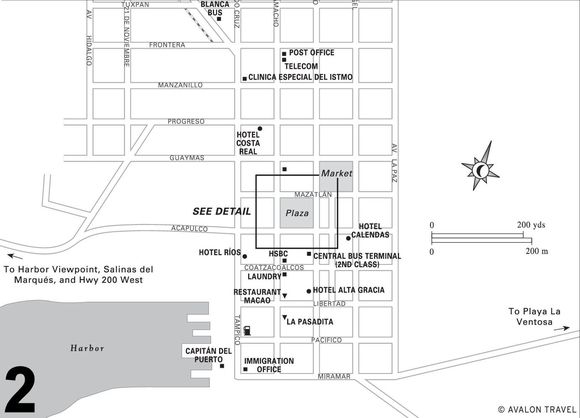
Town activity focuses at the very pungent and busy market, northeast of the plaza, between Guaymas and Mazatlán. Several blocks south of the plaza are the container docks along the Calle Miramar, which leads to the drowsy beach village of Playa La Ventosa.
Once you’ve gotten your fill of the sights and sounds around the plaza and market, head west to breezy harbor vista point Faro del Marina. Drive or ride a Salina-labeled bus or a taxi west along Acapulco, the plaza’s south-side street. First you pass dique (DEE-kay, dry dock) no. 1 and the naval compound, then cross beneath the great rack of pipelines conducting a small river of oil and chemicals over the road. Continue, winding uphill to the summit parking lot on the right. On the harbor’s near side stands the fishing fleet; on the opposite side are the smart gray naval frigates and destroyers. On the right, at the outer pier, great supertankers take on lakes of crude oil, most likely bound for Japan and the United States.
Continue west downhill to Barrio Salinas, named after Hernán Cortés’s salt-producing ponds, the Salinas del Marqués. Although the ponds, about two kilometers (1.2 mi) west of the foot of the hill, still produce salt, they are as interesting for the wildlife—flocks of waterfowl, both resident and local—that they sustain. People also live from the bounty of the salinas. In the afternoons, next to the road that cuts north across the marshes to Highway 200, you can usually see men waist deep in the pond, throwing nets and hoping to haul in something for dinner.
ACCOMMODATIONS
The continuous flow of Salina Cruz visitors supports several hotels. With the exception of the beachfront hostelries in Playa La Ventosa, they are all (excepting one, Hotel Parador) near the town center.
Under $25
A good low-budget choice is the Hotel Ríos (Wilfredo Cruz 405, tel. 971/714-0337, $12 s or d in one bed, $16 d, t, or q in two beds), a block west and half a block south of the plaza. Here, the grandmotherly owner maintains three stories of about 20 plainly furnished but very clean rooms, arranged along corridors around an interior patio. Choose an upper room for more light and privacy. Rooms come with bath (tepid-water shower), fans, and street parking only; credit cards are not accepted.
$25–50
Convenient for travelers with cars or RVs is the Hotel El Parador (Carretera Transistmica Km 6, Colonia Aviación, tel./fax 971/716-2951, $35 d). On the highway’s east side, about six kilometers (four mi) north of town, El Parador’s major attraction is its spacious, palmy, tropical pool patio, perfect for relaxing at the end of a warm, busy day. However, some rooms, although clean, generally lack good ventilation. Consequently, they may smell of moho (mildew), especially during the summer–fall rainy season. Inspect various rooms until you find one that is satisfactory. Rooms come with air-conditioning, hot-water shower-baths, and parking; credit cards are not accepted.
Back in the town center, the Hotel Altagracia (5 de Mayo 520, tel./fax 971/714-0726 or 971/714-6225, emarin_10949@hotmail.com, $30 s, $34 d, $38 t, $42 jr. suite), just a block and a half south of the plaza, offers another good choice. The 18 rooms, in a compact but invitingly decorated two-story block, are clean, with either one king-size or two double beds. They are tastefully decorated in modern style, with tile floors and some marble baths. Amenities include hot-water shower-baths and air-conditioning, Internet access, but street-only parking; credit cards are not accepted.
Nearer to the plaza, find the Hotel Calendas (Puerto Ángel 408, tel. 971/714-4574, calendas _hotel@hotmail.com, $35 s, $40 d, $45 t), one long block east of the plaza, just south of the corner of Acapulco and Puerto Ángel. Savvy managers have created an inviting lodging of about 20 clean, spacious, comfortably furnished rooms in two stories around a quiet interior patio, with hot-water shower-baths, TV, air-conditioning, and parking. Credit cards are accepted.
The fourth choice downtown goes to the pricier Hotel Costa Real (Progreso 22, tel./fax 971/714-0293, $44 s, $47 d, $54 t), two blocks north, half a block west of the plaza. A plus here is the good restaurant, which is especially handy for breakfast. Upstairs, although the approximately 30 rooms are clean and comfortable enough, they do not appear particularly well-maintained. Make sure everything works before you pay. Amenities include hot-water shower-baths, air-conditioning, TV, and parking. Credit cards are accepted.
FOOD
Food is plentiful in downtown Salina Cruz. If you’re on a tight budget, the fondas (food stalls) on the market’s south and west sides will satisfy with hearty country-style soups, stews, rice, tamales, and seafood, with all the tortillas you can eat. For dessert, go to one of the close-in panaderías (bakeries). For example, try La Toya (on Acapulco, 8 A.M.–10 P.M. daily), near the plaza’s southeast corner.
Health food fanciers will appreciate the many shelves of grains, food supplements, vitamins, ginseng, herbs, and remedies at the Centro Naturista Aquarius (Avila Camacho, tel. 971/714-2180, 8 A.M.–8 P.M. Mon.–Sat.); credit cards are accepted. Find it half a block south of the plaza’s southwest corner, just past Restaurant Papagayo.
The first restaurant choice goes to locally popular seafood restaurant  La Pasadita (Avila Camacho, tel. 971/714-0356, 7 A.M.–10 P.M. daily, $6–20), two and a half blocks south of the plaza’s southwest corner. Take a seat in their airy, tree-shaded dining room–patio and choose from a long menu that starts out with many breakfast packages, continues with salads and soups (oysters Rockefeller, oyster cream), and finishes with many styles of fish (breaded, with garlic, whole barbecued), and in season, even jumbo prawns (that they call cucarachas) and lobster. Credit cards are accepted.
La Pasadita (Avila Camacho, tel. 971/714-0356, 7 A.M.–10 P.M. daily, $6–20), two and a half blocks south of the plaza’s southwest corner. Take a seat in their airy, tree-shaded dining room–patio and choose from a long menu that starts out with many breakfast packages, continues with salads and soups (oysters Rockefeller, oyster cream), and finishes with many styles of fish (breaded, with garlic, whole barbecued), and in season, even jumbo prawns (that they call cucarachas) and lobster. Credit cards are accepted.
On the other hand, for Chinese food, you have refined Restaurant Macao Cantonesa (Avila Camacho, tel. 971/714-3834, 9:30 A.M.–7:30 P.M. daily, $3–7), which carries on Salina Cruz’s Asian-food tradition, about two blocks south of the plaza’s southwest corner. Diners choose from a long, very recognizable menu, including lots of meat, fish, and chicken dishes, such as almond chicken, pork chow mein, and spareribs. Lighter eaters can skip the meat and ask for rice and vegetables, such as broccoli, cabbage, tomatoes, and mushrooms only and get reduced prices.
Also among the town center’s recommendable sit-down eateries is locally popular Restaurant Papagayo (Avila Camacho 407, tel. 971/714-2084, 8 A.M.–10 P.M. daily, $2–6), half a block south of the plaza’s southwest corner. The Chinese-Mexican owners once offered some Asian food favorites, but now they’ve switched exclusively to Mexican and international specialties. These include good breakfasts (hotcakes, bacon, eggs), lunches, or dinners (hamburgers, tortas, soup, salad, fish, chicken).
For a modicum of tranquility and plain good food, try the dining room of the Hotel Costa Real (Progreso 22, tel./fax 971/714-0293, 7:30 A.M.–10:30 P.M. Mon.–Sat., $4–12), two blocks north, half a block west of the plaza’s northwest corner.
For dessert, try Starbucks look-alike Italian Coffee Company (corner of Acapulco and Avila Camacho, tel. 971/720-2840, 9 A.M.–11 P.M. daily), on the southeast plaza-front corner. Take in the refined, air-conditioned ambience, while relaxing to soothing recorded melodies, sampling the rich espresso coffees, and snacking on sandwiches (panini, croissant) or desserts (cakes and brownies).
ENTERTAINMENT AND EVENTS
True to Tehuántepec tradition, Salina Cruz folks sometimes abandon their workaday habits for fiestas. First comes the Fiesta de la Santa Cruz (May 3), in a blast that includes coronation of a queen, full-costumed traditional dances, a fruit- and gift-throwing regada parade, carnival rides and games, and fireworks.
If you miss that fiesta, you might be lucky and get in on one later, such as the Fiesta del Pueblo, an all-purpose town fiesta, for several days beginning May 9; the Fiesta de Santa Rosa de Lima (Aug. 26–Sept. 2); the Fiesta de San Francisco Asis (Oct. 3–5); and the Fiesta de San Diego (Nov. 11–16).
INFORMATION AND SERVICES
Health and Emergencies
A good choice for over-the-counter medications is Farmacia Similares (Generics Pharmcacy; Mazatlán, tel. 971/714-1670, open 24 hours daily), a few doors from the plaza’s northwest corner.
Probably the most solid in-town medical clinic is the very professional Clinica Especialidades Medica del Istmo (Tampico 5, between Manzanillo and Frontera, tel. 971/714-5074). They have several specialists (internist, opthamalogist, pediatrician, gynecologist, pathologist, gastroenterologist, psychiatrist, and dentist) for office consultations and hotel calls.
Alternatively, right on the plaza’s west side, the Clínica de Especialidades Médicas (Medical Specialties Clinic; Avila Camacho 306, tel. 971/714-4107, 9 A.M.–5 P.M. Mon.–Sat.) offers consultations with either gynecologist, pediatrician, ophthalmologist, or dentist.
In a medical emergency, either follow your hotel’s recommendation or have a taxi take you to Sanatorio del Carmen (clinic and pharmacy; Calle Francisco Villa 16, tel. 971/714-1180). In a police or fire emergency, contact the policía municipal (tel. 971/714-0523).
Money
Several banks, all with ATMs, serve downtown customers. A good first choice is HSBC (northeast corner of Avila Camacho and Coatzacoalcos, tel. 971/714-4476, 8 A.M.–6 P.M. Mon.–Fri.), a block south of the plaza. Alternatively, also on Avila Camacho, try Bancomer (Avila Camacho, tel. 971/714-0032, 8:30 A.M.–4 P.M. Mon.–Fri., 10:30 A.M.–I 2:30 P.M. Sat.), on the east side of the streetaI few steps north of the plaza; or Banorte (tel. I 971/714-4454 or 971/714-5898, 9 A.M.–4 P.M. I Mon.–Fri., 9 A.M.–2 P.M. Sat.), on the west I side of the plaza, near the plaza’s northwest I corner.I
Communications
The town correo (east side of Avila Camacho, corner of Frontera, tel. 971/714-0040, 8 A.M.–7 P.M. Mon.–Fri., 8 A.M.–4 P.M. Sat.), with Mexpost secure mail service, and the Telecom (east side of Avila Camacho, corner of Frontera, tel. 971/714-0891, fax 971/714-0760, 9 A.M.–7:30 P.M. Mon.–Fri.), stand side by side, four blocks north of the plaza. Moreover, a larga distancia telephone office (7 A.M.–midnight daily) serves customers at the plaza’s southeast corner.
A number of small storefronts provide Internet connection. Try Cybernet (7 A.M.–7 P.M. daily) near the plaza’s southeast corner. Alternatively, go to C-Rent Internet (5 de Mayo 705, tel. 971/714-1839, 9 A.M.–2 P.M. and 4–10 P.M. Mon.–Sat.), on the plaza’s northwest corner, across Avila Camacho and opposite Bancomer.
Immigration
Being a port of entry, Salina Cruz has a Migración (Immigration Office; tel. 971/714-1000 or 971/714-4531, 9 A.M.–1 P.M. Mon.–Fri.), at the foot of Tampico, four blocks south of the plaza. Go there if you lose, or need an extension on, your tourist permit.
If you arrive by private boat and have inspection documentation from another Mexican port, present it for check-in at the Capitán del Puerto, located just west of Migración, across Tampico. If you arrive without Mexican inspection documentation, first go to Migración for an inspection, then to the Capitán del Puerto.
Car Rental
Rent a VW bug (minimum $40/day) at Lone Star (tel./fax 971/716-2650, bubistmo@hotmail.com, 9 A.M.–7:30 P.M. Mon.–Sat.), on the north outskirts, along the Tehuántepec highway, about two kilometers (1.2 mi) from downtown.
Photography and Laundry
The best town source for cameras (Kodak, Konica, and Fuji), developing (both film and digital), and supplies is Foto Discuento de Oaxaca (Avila Camacho, tel. 971/714-4300, 9 A.M.–8 P.M. Mon.–Sat.), half a block north of the plaza.
Get your laundry done at Lavandería Carmel (southeast corner of Avila Camacho and Coatzacoalcos, tel. 971/714-6105, 9 A.M.–9 P.M. Mon.–Sat., 9 A.M.–noon Sun.), a block south of the plaza’s southwest corner.
GETTING THERE AND AWAY
Three terminals serve Salina Cruz bus travelers. The two first-class terminals are on the north side of town. At Calle Laborista 2, corner of Highway 200, about seven blocks north of the plaza, computerized Omnibus Cristóbal Colón, Plus, and Autobuses del Oriente (ADO) (all bus lines contactable by local tel. 971/714-0703) offer first-class and luxury service (that can also be booked and paid for by credit card via the Ticket Bus agency’s toll-free Mex. tel. 800/702-8000).
Cristóbal Colón departures connect northwest with Mexico City (Norte and Tapo terminals) via Tehuántepec and Oaxaca City; west with Bahías de Huatulco, Pochutla (Puerto Ángel), and Puerto Escondido; and east with Juchitán, Zanatepec, Tuxtla Gutiérrez, San Cristóbal las Casas, and Tapachula on the Guatemala border. Its subsidiary line, Plus, offers luxury-class connections northwest with Oaxaca City, Mexico City, and Veracruz; and southwest with Bahías de Huatulco.
ADO offers luxury-class connections in three directions: northwest, via Juchitán and Puebla, with Mexico City Tapo terminal; northeast, via Villahermosa, with Merída and Cancún; and west, via Tehuántepec, with Huatulco, Pochutla (Puerto Angel), and Puerto Escondido.
At the other first-class terminal, also on Highway 200, five blocks north of the plaza, Estrella Blanca (tel. 971/714-5548) and its subsidiary lines offer first- and luxury-class connections along the Highway 200 corridor with Huatulco, Pochutla–Puerto Ángel, Puerto Escondido, and Acapulco (where connections may be made northwest, for Zihuatanejo, Puerto Vallarta, and the U.S. border), and Mexico City.
The second-class bus terminal (5 de Mayo, tel. 971/714-0259) is downtown, half a block south of the plaza. Here, Autobuses Unidos (AU) offers connections northwest with Oaxaca, Puebla, Mexico City, Orizaba, and Veracruz; and north with Tehuántepec, Juchitán, and Tuxtepec. Sur offers connections north, with Tehuántepec, Juchitán, and Coatzacoalcos; east with Zanatepec and Tapanatepec; and southwest with Astata and Bahías de Huatulco.
Drivers have the same highway choices and destinations as Tehuántepec. Simply add 20 minutes to the driving time (and 15 km/nine mi distance) for northerly, northwesterly, and easterly trips; subtract the same for southwesterly trips. Fill up with gasoline at the Pemex gasolinera on the highway, Tehuántepec direction, about six kilometers (four mi) north of downtown.
PLAYA LA VENTOSA
Playa La Ventosa is Salina Cruz’s sleepy little beach village on the historic Bahía de la Ventosa (Windy Bay), where Hernán Cortés built his first caravels to explore the Pacific. Get there by car, taxi, or white or orange Ventosa-labeled bus running west along Calle Miramar next to the container docks, four blocks south of the plaza. Drivers, bear left at the fork at the end of Miramar and continue winding over the hill toward the beach. After about three kilometers (two mi), you get a good view of the petrochemical plant on the left, belching a swirling, hellish plume of pollution. Fortunately for Salina Cruz (but not for other towns downwind), prevailing breezes blow the smoke in a northerly direction, away from town.
At about six kilometers (four mi) from downtown, you arrive at Playa La Ventosa. One of the best places to land is La Palapa de Chava, the beachfront restaurant at the end of the main street through town. Friendly, knowledgeable owner Salvador Mendoza likes to tell visitors about Playa La Ventosa. He says that wood for Cortés’s ships was cut inland and floated downstream via the Río Tehuántepec, which empties into the bay’s east (left, facing the ocean) side. There, the summer rainy-season flood stains the entire Bahía Ventosa a muddy brown while depositing piles of driftwood on the east-side beach. In the dry winter and spring, the river dries to a clear trickle and the bay becomes clear and blue.
Shift your view west and notice what appears to be a tower atop the headland, a mile or two beyond the foreground bay and beach. This tower has been known for longer than anyone remembers as El Faro de Cortés (The Lighthouse of Cortés). The tower’s builders cut a window on the seaward side, where historians believe they placed an oil lamp to guide ships to the harbor.
If the story is true, the lighthouse would be nearly five centuries old. How could this be? Without maintenance, mortar crumbles and bricks usually fall after two or three centuries. Restaurant owner Salvador Mendoza answers that experts believe that Cortés built the tower of bricks and mortar, mixed with egg whites and yolks instead of water, which made the mortar durable enough to keep the lighthouse standing straight, without any repairs, through the present day.
Activities
Wander the beach, rocky in the rainy summer and fall, sandy in the dry winter and spring. On the east side, by the river’s mouth, collect shells and driftwood, watch the antics of the pelicans, seagulls, and cormorants, and, with your binoculars, look for rarer species. On the west side, explore the tide pools beneath the rocky headland, then head inland and hike the headland’s forested arroyos up to the breezy hilltop for a close-up view of El Faro de Cortés.
On another day, go on a fishing excursion and catch a load of silvery mojarra (bass), lisa (mullet), and sierra (mackerel) for a feast for everyone in the neighborhood. Go in your own boat or hire a fisher (figure about $60) to take you out for half a day.
Accommodations
For accommodation, either park your RV, set up a tent, or stay in one of the Playa La Ventosa beachfront lodgings. On the far west side of the beach, beneath the headland, is a secluded, level grassy spot that appears fine for tenting. RV-equipped travelers could simply park at one of a number of likely spots down by the beach.
Otherwise, stay at La Ventosa’s rustic best, sleepy Posada Rústrian (tel. 971/714-0450, $12 s, $24 d), so relaxing that it’s worth reserving well ahead of time if you plan to arrive during high-occupancy times around Christmas, Easter, weekends, and January–April. Posada Rústrian amounts to a downscale mini-resort, perched on a breezy rise with a palm-fringed beach view. Watch for the side road on the left (across from mini-store “Miscelanea de Diaz”) as you’re entering town. There are no TVs and no phones, simply about 20 basic rooms and a breezy, shaded restaurant with chairs and hammocks for resting, reading, and taking in the view. Rooms (check for maintenance and cleanliness before moving in) have fans and room-temperature private shower-baths.
EAST OF SALINA CRUZ: HUAVE COUNTRY
The country due east of Salina Cruz is one of the low-lying, barrier-sand spits to which many of Oaxaca’s Huave-speaking people were marginalized by the more populous Zapotecs long before the Spanish arrived. The Spanish simply continued the segregation that was already in place.
The Huave appear to have grudgingly accepted their lot. They subsist mostly off of the cattle that graze whatever brush, grass, and cactus grow in the sand and the fish and shrimp that they can catch in the ocean and the lagoons.
San Mateo del Mar
San Mateo del Mar (pop. 2,000), seat of the municipio of the same name, has a uniquely picturesque church and a native market, making it the major destination of this eastern excursion. Get there by heading one hour east (29 km/18 mi) from the jumping-off spot on Highway 200, near Km 17.
The plaza-center of San Mateo del Mar is a block or two south (turn right) from the entrance road. The main sights are the market, which takes up much of the town plaza; the lagoon, past the plaza, a block south; and the church, just to the east of the plaza, with a unique colorful facade.
The market is where most of the town action takes place. Women are the actors and Huave is the language. Dress appears to be the dividing line: The women who wear traje—red blouse, dark skirt, striped cloth headdress trailing a bright ribbon—seem to be the ones who speak Huave only. Besides selling a few vegetables, they mostly offer the local fish and shrimp that their husbands have caught and they’ve dried in the sun.
Despite their historical shyness (most likely based on a communal memory of hard experience), you might get a smile when you say “Buenos días” or “Buenas tardes.” The Huave reticence shows directly in the way they build their homes. Notice the walls—the older ones of sticks or brush, now increasingly of concrete—that surround each family compound. In some country lots, concrete walls appeared to have been built even before any buildings. (This, of course, is not unlike what a significant fraction of town Mexicans do, especially the well-to-do, who have historically surrounded their houses with brawny fences and encased their windows with steel bars.)
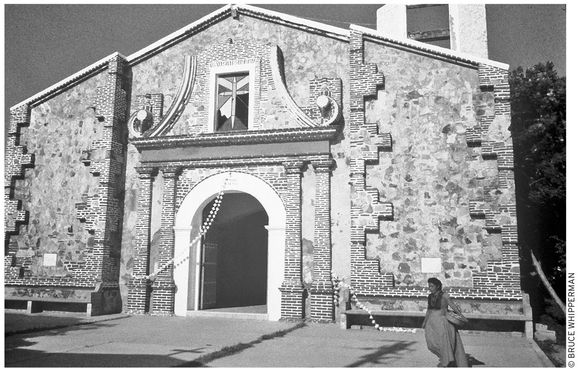
Its market and invitingly picturesque church are prime reasons to visit San Mateo del Mar.
GETTING THERE
Go by bus (ask for a “San Mateo del Mar” bus at the Salina Cruz market) or by car. The road (initially paved but potholed, finally good, all-weather gravel; keep your speed down) takes off from near Highway 200 Km 17 about five kilometers (three mi) north of town. If by bus, ride a taxi from town to (ask your taxi driver to drop you at) the San Mateo del Mar bus stop (parada).
By car, on Highway 200, turn right at the highway traffic signal and road that heads east, across the highway from the big electrical sub-station. Drivers, set your odometer. After about five blocks, follow the traffic left; continue straight about three kilometers (two mi), passing through the traffic circle at the Pemex refinery gate. Cross the Río Tehuántepec at kilometer 7.6 (mi 4.7). After the river bridge, follow the right road fork, and continue for about another 21 kilometers (13 mi) through a couple of hamlets just before San Mateo del Mar, 29 kilometers (18 mi) from Highway 200.
Santa María del Mar
If you have another two hours, continue 16 more kilometers (10 mi) to smaller Santa María del Mar (pop. 500). Here, you’ll find a sleepier town plaza and a humbler church. For a bit of beach action, turn north (left) from the plaza to the embarcadero (wharf), on the Laguna Inferior beach, about two kilometers (1.2 mi) from town. A detachment of marines guards the beach, apparently to keep order among the locals. The guards seemed unconcerned with me as I drove past their post.
A battalion of fishing lanchas lines a broad, breezy beach. Gentle waves wash the shallow shoreline, and dogs laze in the sun. With the added security of the marines, this appears to be an especially good spot for prepared tenters or RVers (bring water and food). The most exciting time is mid- to late afternoon, when the fisherfolk bring in their catches. They sell whatever they can to buyers who arrive with trucks, and load the rest on wheelbarrows, which they push home for drying. The good shrimp price that the buyers were paying—about $4.50 per pound—reflects both local and world demand.
JUAN CATALINA ROMERO: HEROINE OF TEHÚANTEPEC
Why Tehuántepec’s main downtown streets, which carry such nationally renowned labels as 5 de Mayo, Benito Juárez, and Hidalgo, should include Juana C. Romero among them is a question nearly all adult townsfolk can immediately answer. “Doña Juana,” they say, is Tehuantepec’s heroine because she “built schools and helped the children of Tehuántepec.” Some go on to say that she “got lots of help for Tehuántepec from her friend, Presidente Porfirio Díaz.”
When pressed, most Tehuántepec folks acknowledge that she had a close (some even say intimate) relationship with Porfirio Díaz. Juana Catalina was a 21-year-old Zapotec beauty when she was first introduced to Diaz in 1858. At that time, he was an ambitious young captain in the army of President Benito Juárez Stuggling to win the bloody see-saw civil War of the Reform that pitted liberal against conservative forces everywhere in Mexico.
Although he must have been charmed by her at their first meeting, most certainly nothing immediate came of it, since, when he proposed to her, she turned him down. People say that she told him, “Yours is a liberal mission, with President Juárez, to save Mexico, while my mission is here in Tehuántepec, helping my people.”
Whatever passed between them during later years has been the subject of endless gossip. What is certain, however; is that she never married, and they were certainly close confidantes. Moreover, Don Porfirio had the railroad tracks laid right past her house in downtown Tehuántepec, because, it is speculated, he could hop off the train and visit her any time with no fuss or muss.
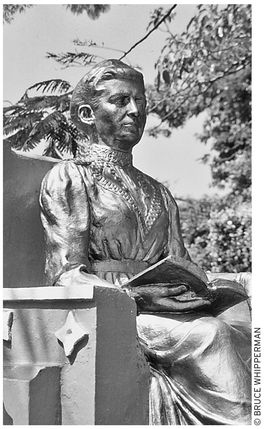
Juana Catalina Romero is fondly remembered by Tehuántepec people for her kindness and good works.
SCOOTING AROUND BY MOTOCARRO
The city of Tehuántepec’s public transportation system was long ago preempted by the town’s regiment of motocarros–small, motorcycle-driven flat-bed trucks that buzz, putt, squeal, and skid around town continuously. The center of the action is the railroad track behind the market, where all Tehuántepec motocarros faithfully return for passengers and cargo.
Motocarros have thus become the end-all answer to how to get around in Tehuántepec’s heat. Long ago, everyone (excepting mad dogs and Englishmen) learned that too much midday walking can produce a considerable sweat at best and sunstroke at worst. If you get overheated, do as Tehuántepec people do and take a seat in the shade and cool down with an agua or refresco. Later, continue your breezy extended tour via motocarro. Fares run about $1 for an entire circuit of the town.
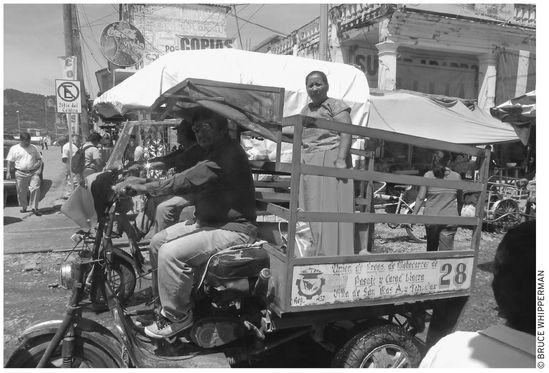
Beat the heat by riding around town in a motocarro.
VELAS: FIESTAS OF THE ISTHMUS
The Isthmus velas amount to a near-continuous regional party. People stay up all night, sometimes for days on end of feasting, drinking, dancing, and parading with family and friends, many of whom return from afar to renew cherished old relationships. What follows is a short list that includes only the most important Isthmus velas. (Note: * especially recommended)
| DATE | PLACE | FESTIVAL |
|---|---|---|
| January 18–21 | Jalapa del Marqués | San Sebastián de las Flores |
| First Friday of Lent | San Pedro Huamelula | Carnaval |
| February 20–25 | Matías Romero | Vela San Matías |
| First days of April | San Pedro Tapanatepec | Feria de Mango |
| April 15 | Juchitán | Vela Ique Guia |
| April 25 | Juchitán | Vela Ique Guidxi |
| April 27 | Juchitán | Vela Paso Cru |
| May 3 | Juchitán | Vela Guzebenda |
| May 3–6 | Salina Cruz | Santa Cruz |
| May 5 | Juchitán | Vela Quintu |
| May 8 | Juchitán | Vela Guigu Dixta |
| May 10 | Juchitán | Vela San Pedro Cantarito |
| May 13 | Juchitán | Vela San Isidro Guete |
| May 15 | Juchitán | Vela Guela Bene |
| May 16 | Juchitán | Vela Iguu |
| Last 15 days of May | Juchitán | *Fiesta de San Vicente Ferrer |
| Juchitán | Vela Biadxi | |
| Juchitán | Vela Calvario | |
| Juchitán | *Vela Angelica Pipi | |
| Juchitán | *Vela San Isidro Labrador | |
| Juchitán | *Vela San Vicente Chico | |
| Juchitán | *Vela San Vicente Grande | |
| Juchitán | *Vela de Cheguigo | |
| Last week of May | Tehuántepec | Vela Sandunga |
| June 16 | Juchitán | Vela San Antonio |
| June 24 | Juchitán | Vela San Juan Bautista |
| Juchitán | Vela Taberneros | |
| Juchitán | Vela Coheteros | |
| June 24–30 | San Pedro Huamelula | Fiesta del Apóstol San Pedro |
| June 27–30 | San Pedro Tapanatepec | Fiesta Patronal de San Pedro |
| July 21–29 | Santiago Laollaga | Fiesta de Santiago Apóstol |
| July | Juchitán | Vela de los Niños |
| August 13 | Juchitán | Vela Asunción |
| August 15 | Juchitán | Vela San Jacinto |
| August 13–16 | Jalapa del Marqués | Fiesta de la Asunción |
| August 13–18 | Tehuántepec | * Fiesta Patronal del Barrio de Santa María Reoloteca |
| August 31–September 11 | Tehuántepec | * Fiesta del Laborio |
| September 3 | Juchitán | Vela de la Familia Pineda |
| September 4 | Juchitán | Vela de la Familia López |
| September 5 | Juchitán | Vela del Triunfo del Batallón Juchiteco de 1866 |
| Juchitán | Vela Superior | |
| October 1–4 | San Francisco Ixhuatan | Vela del Santa Patrón |
| December 26 | Tehuántepec | *Vela Tehuántepec |
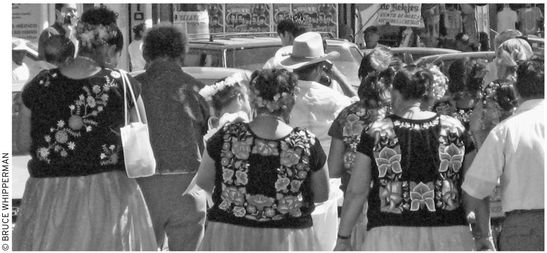
Velas (festivals) usually start off with a calenda (procession) in which the women dress up in their finest flowered huipiles.
